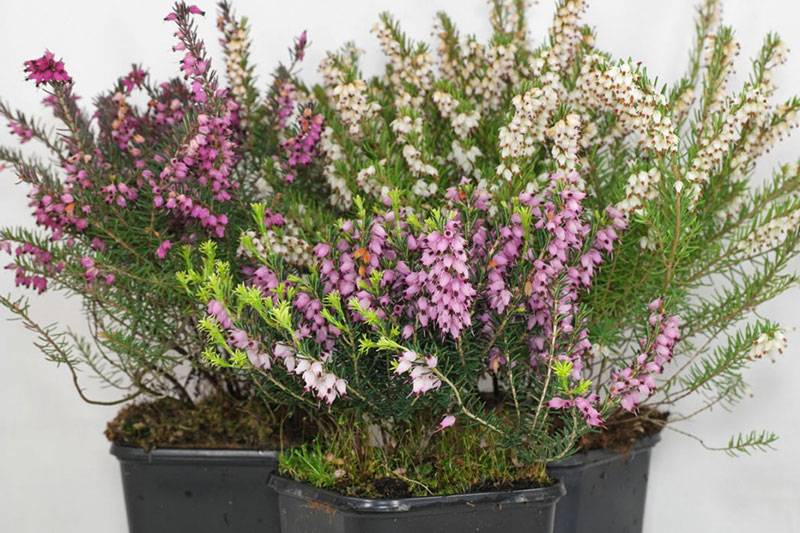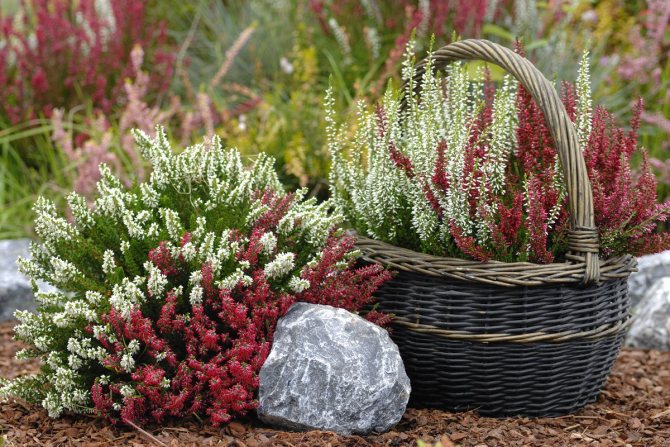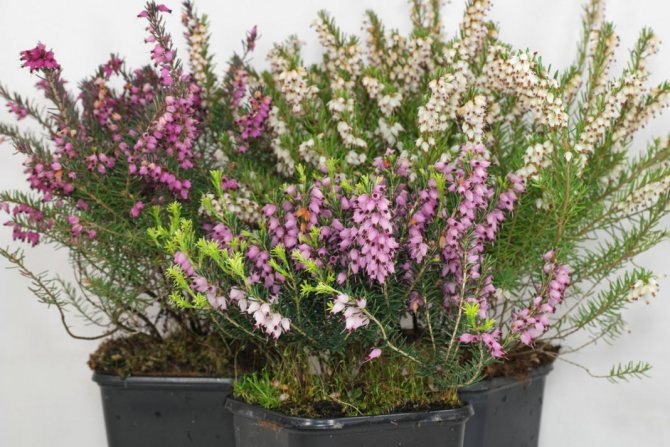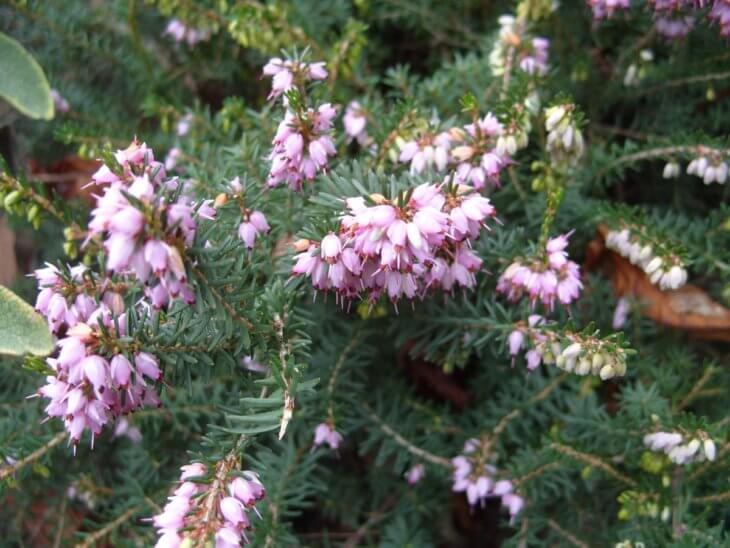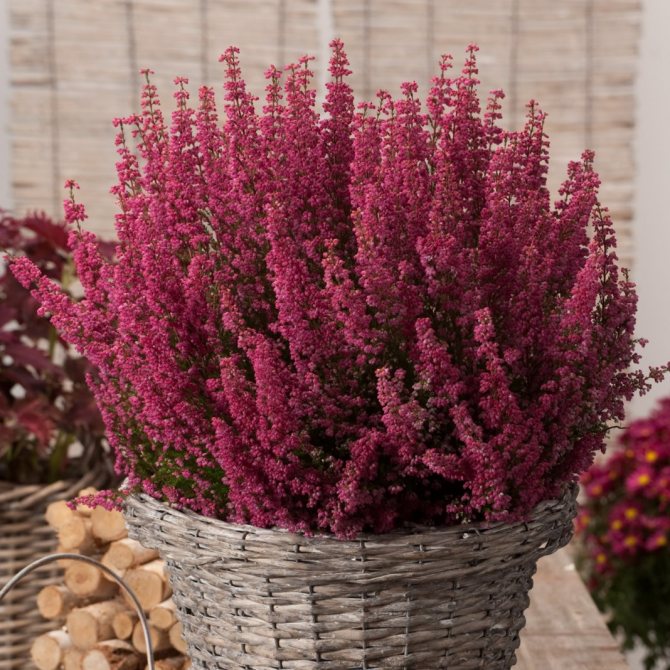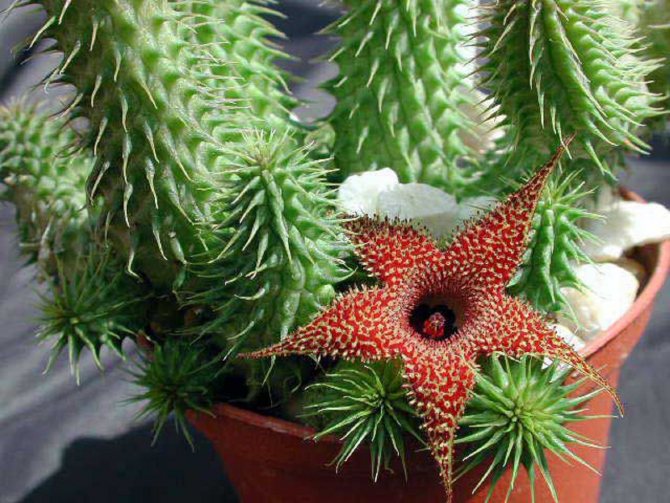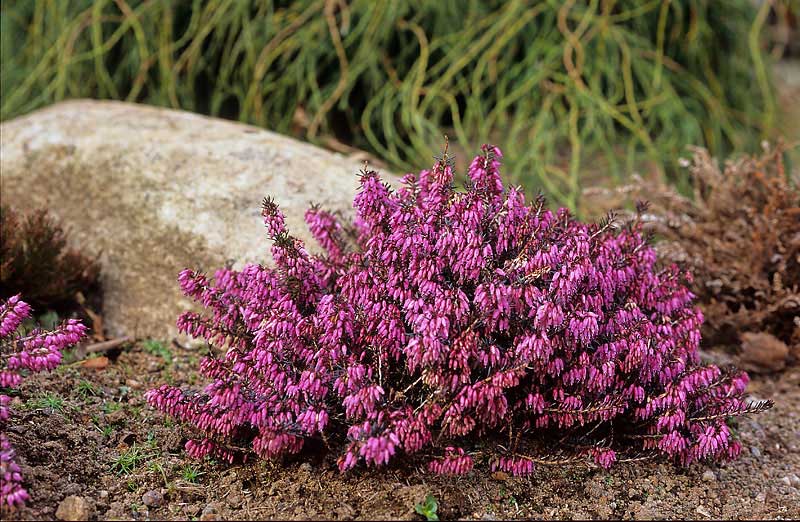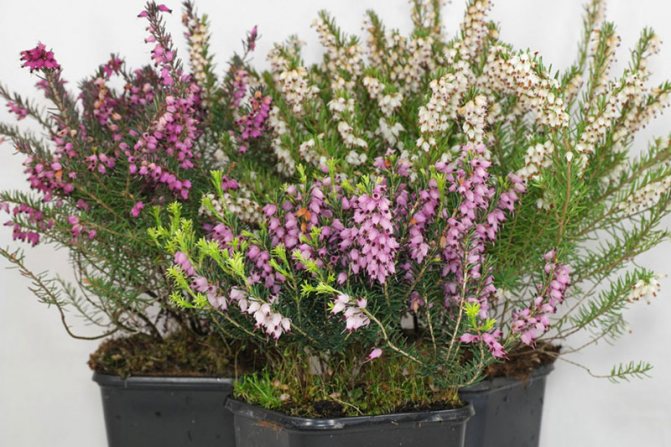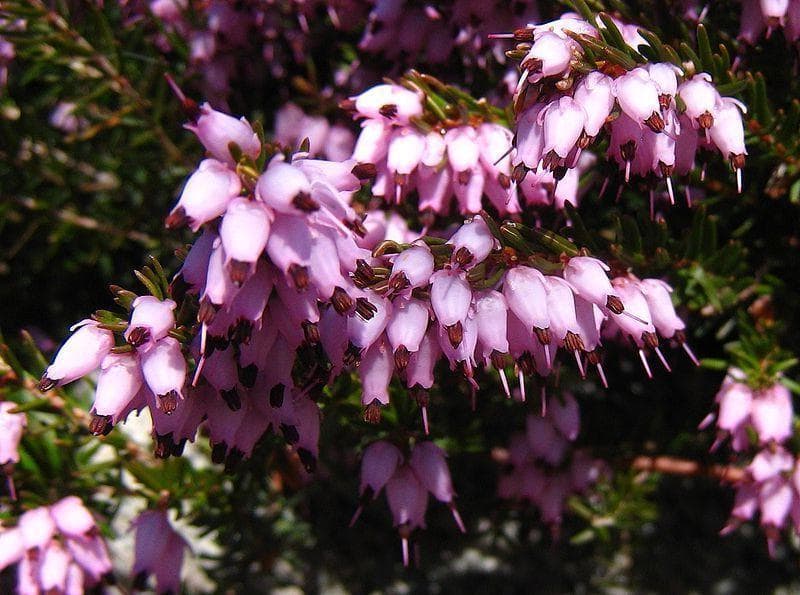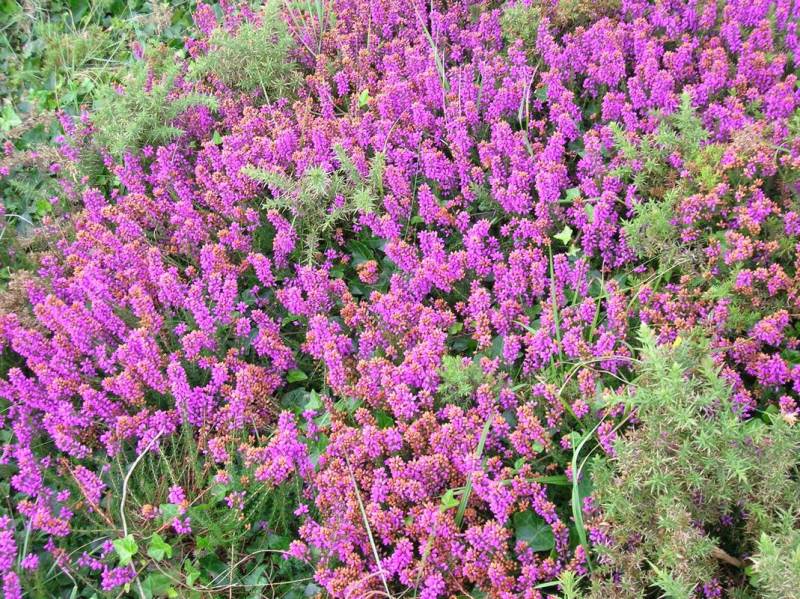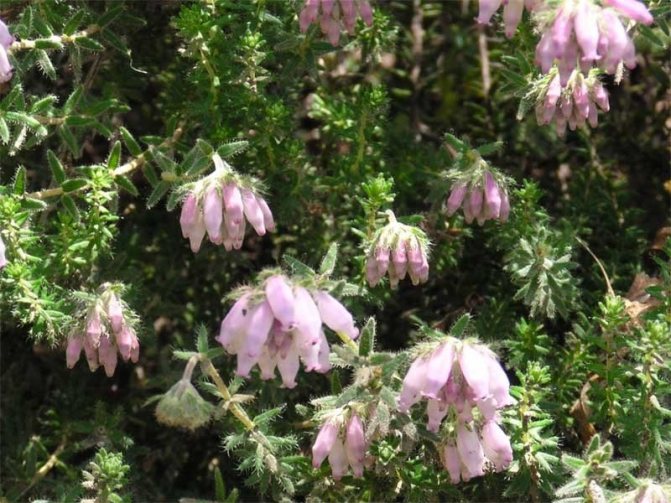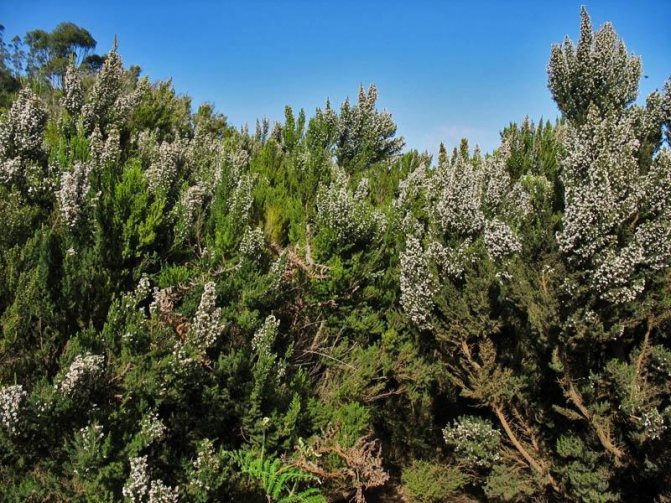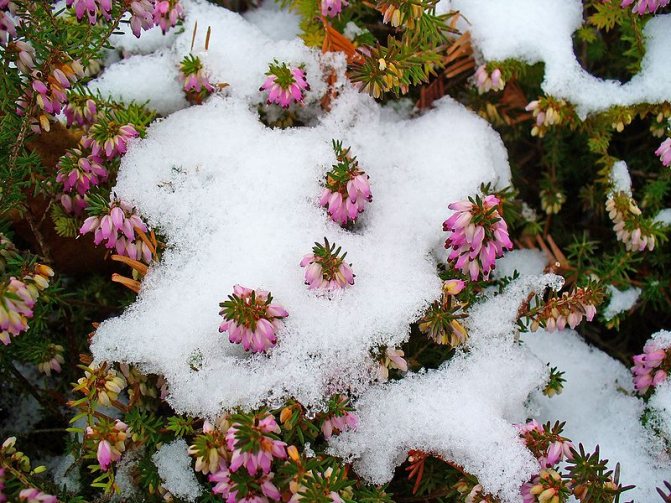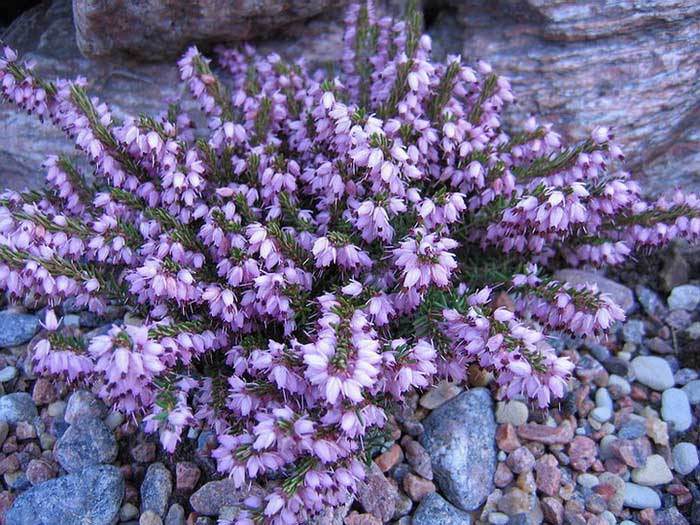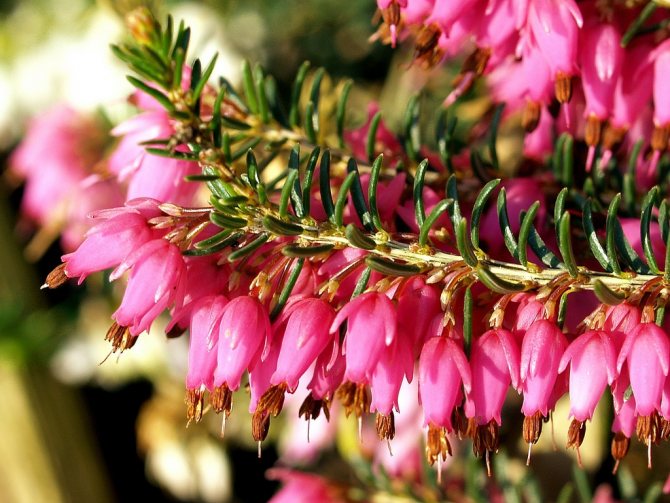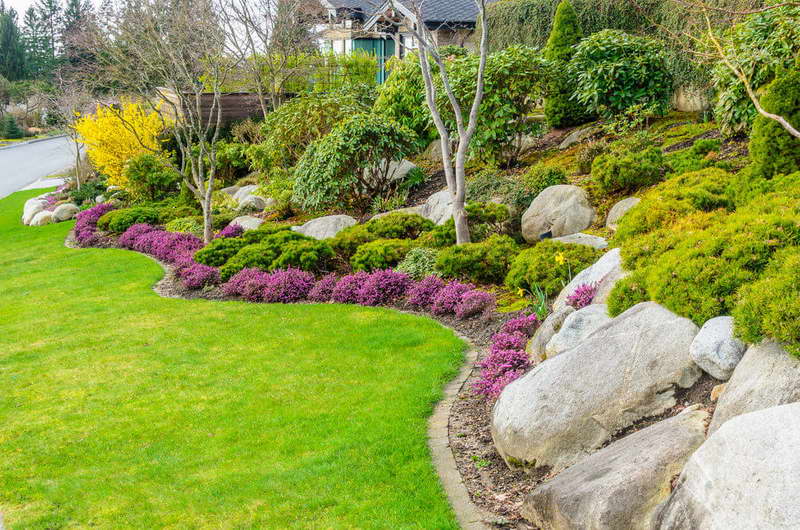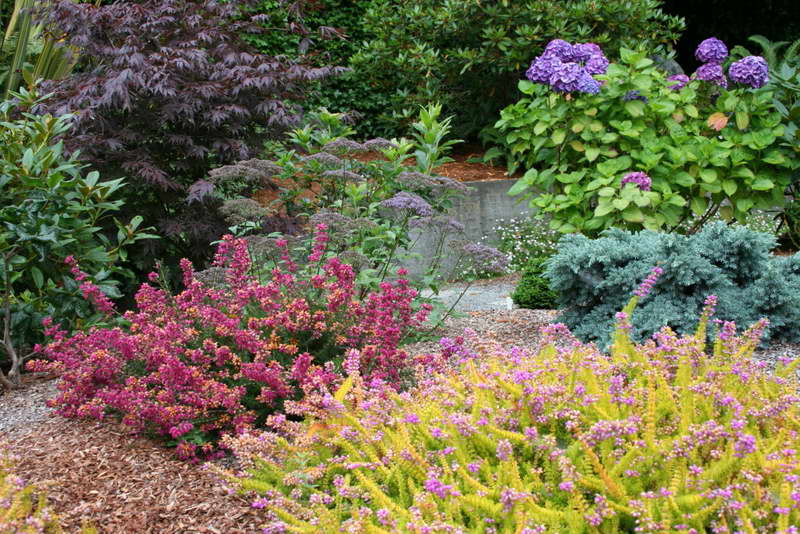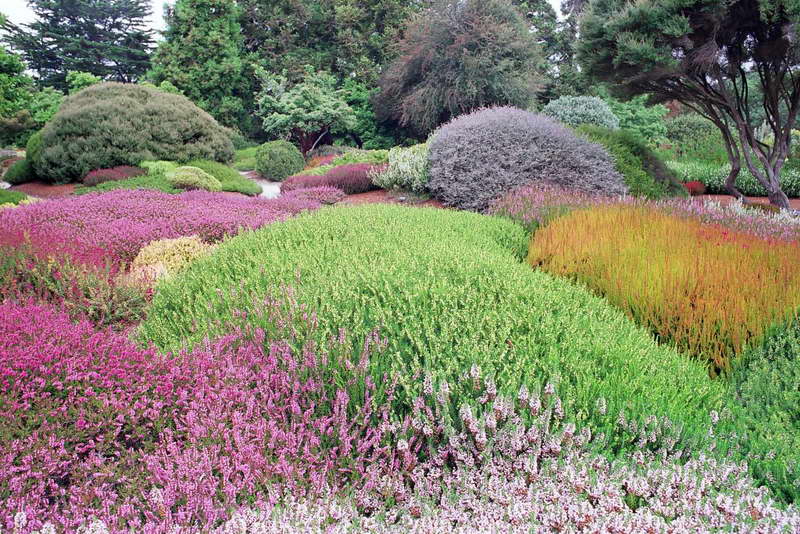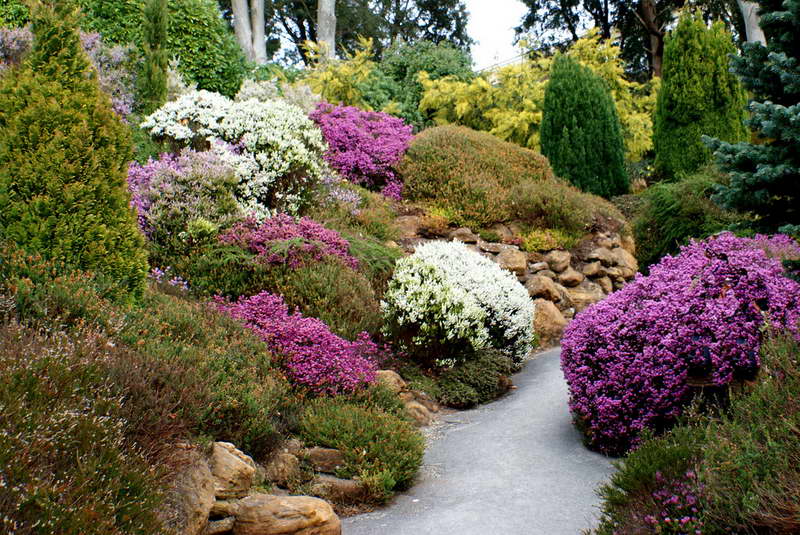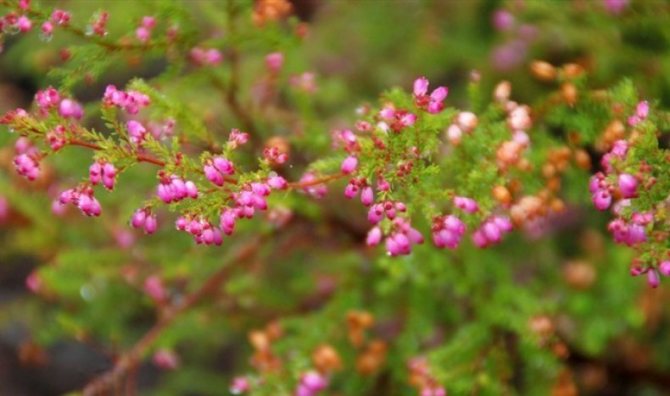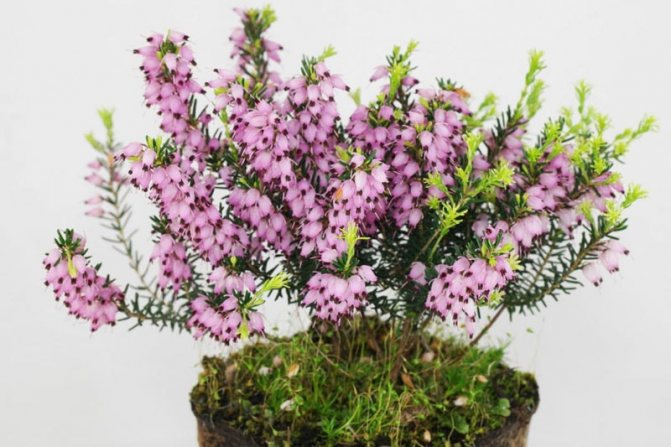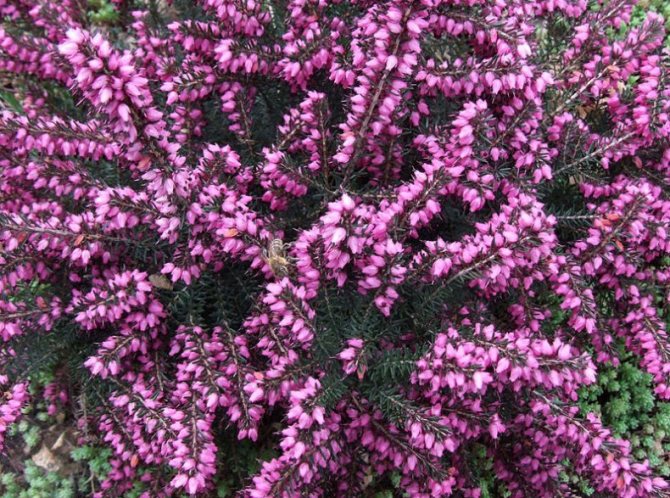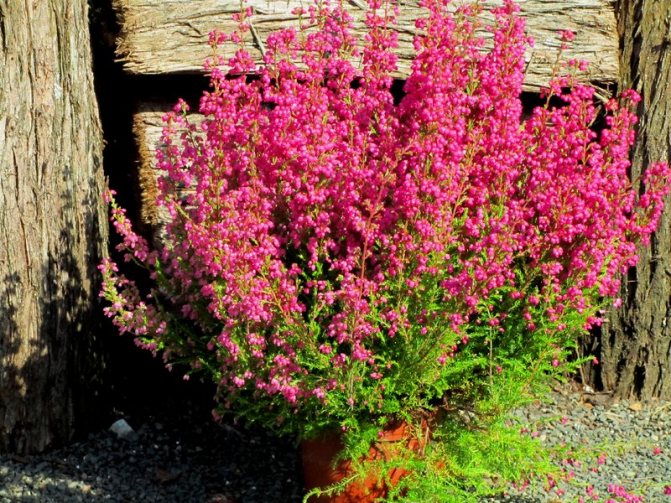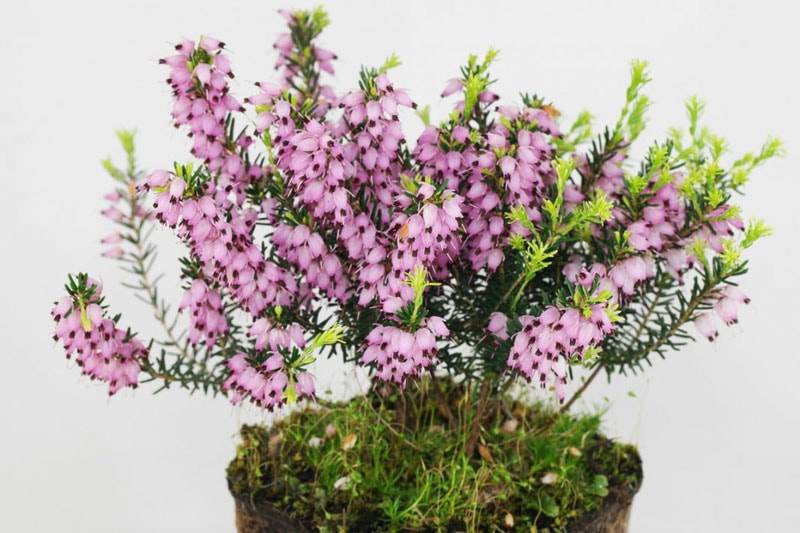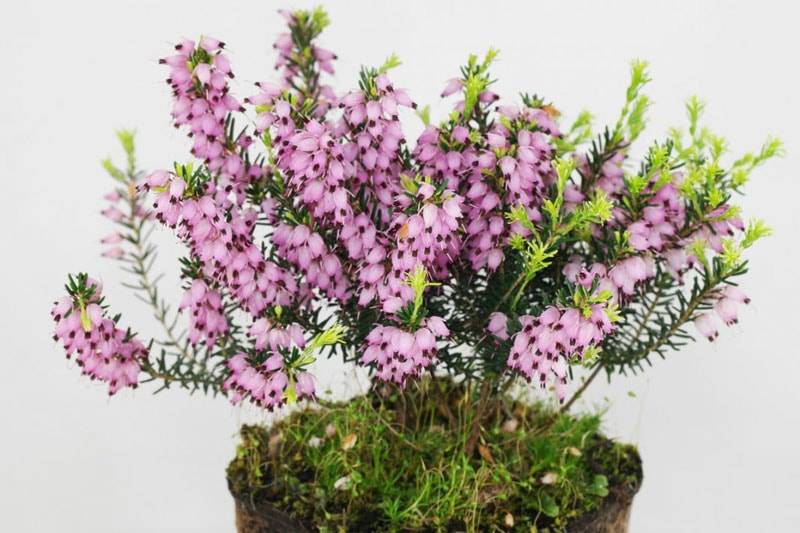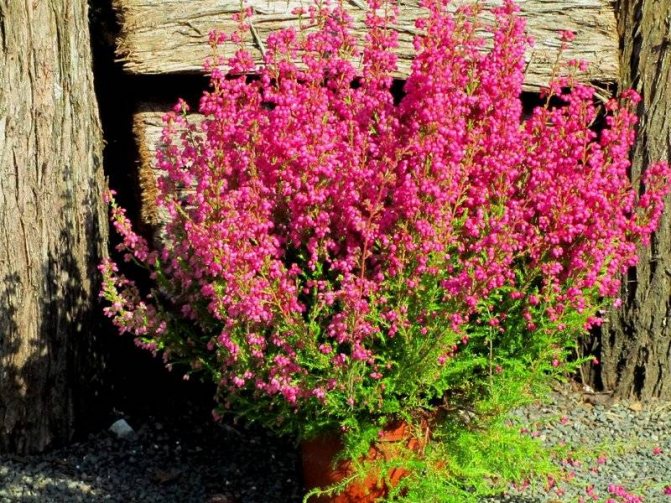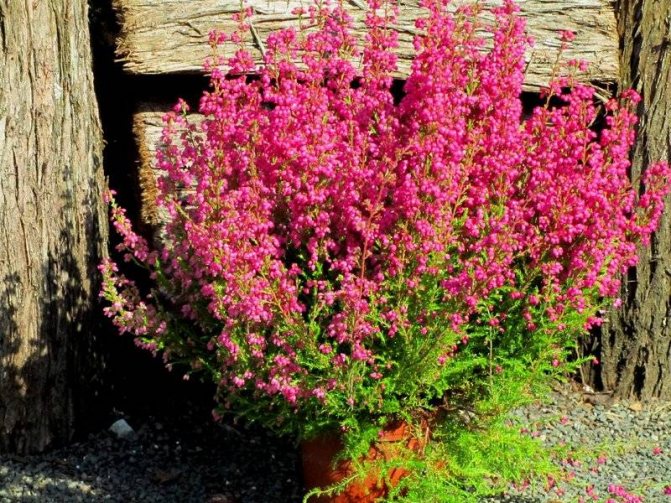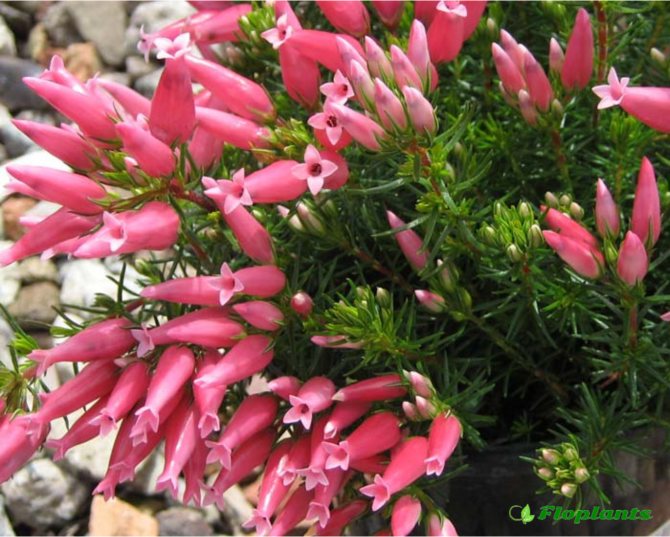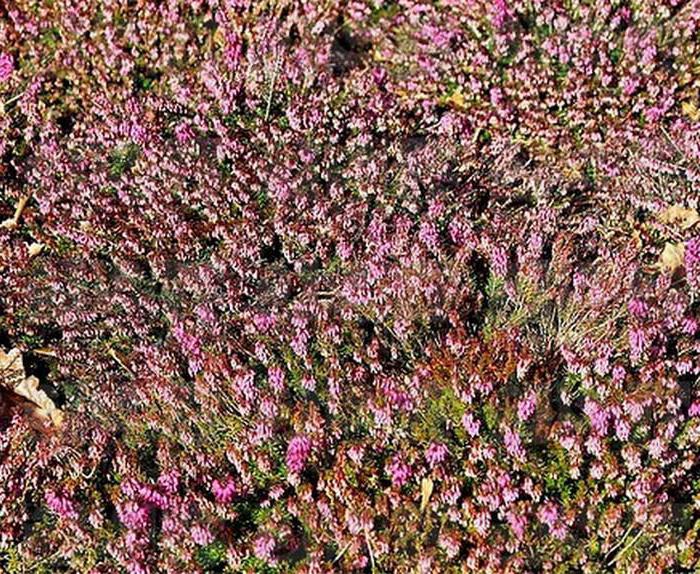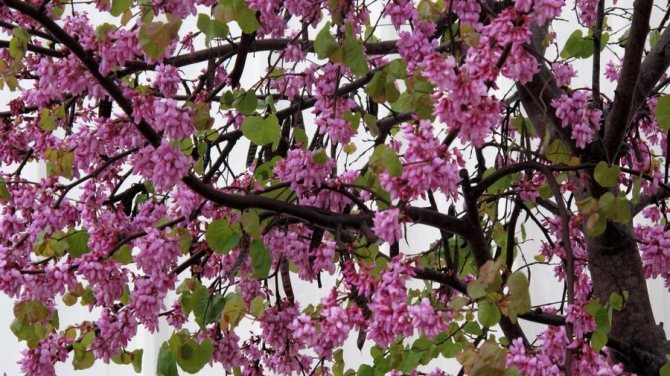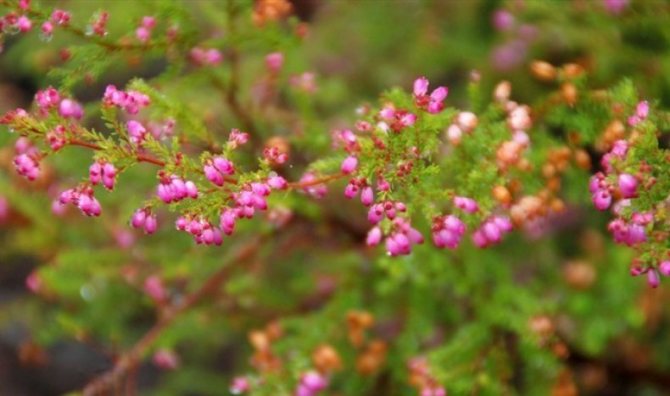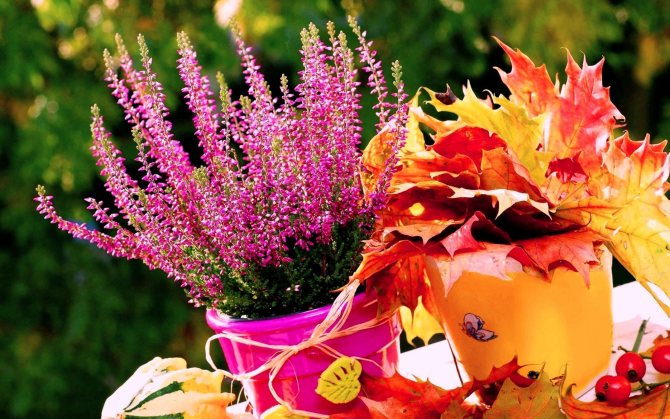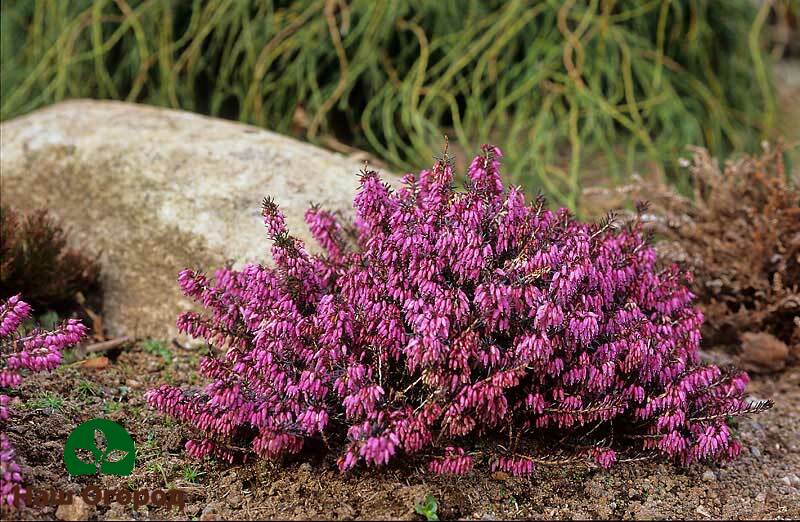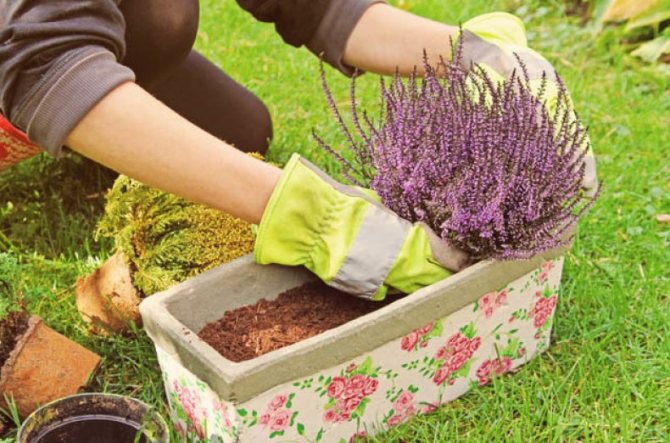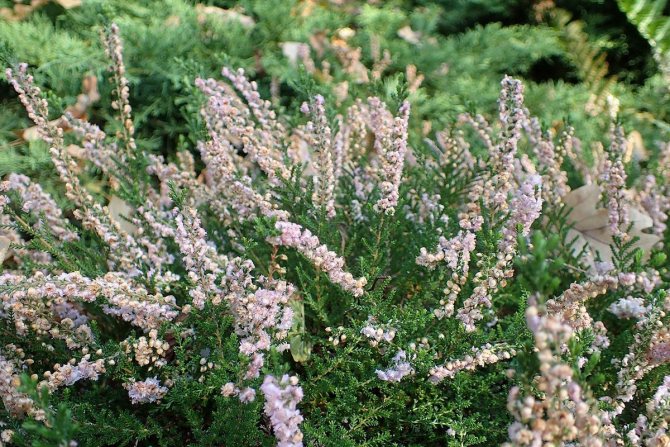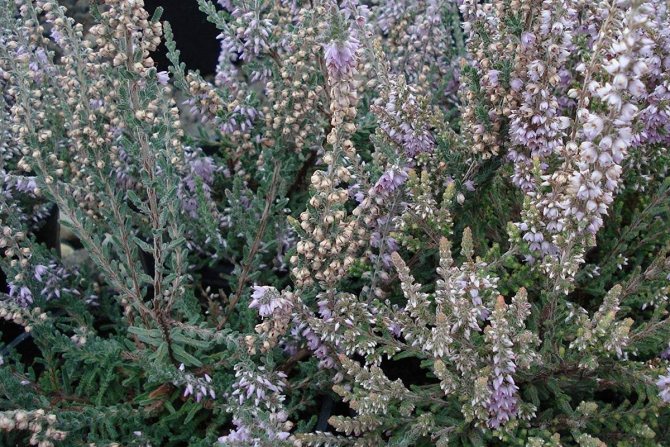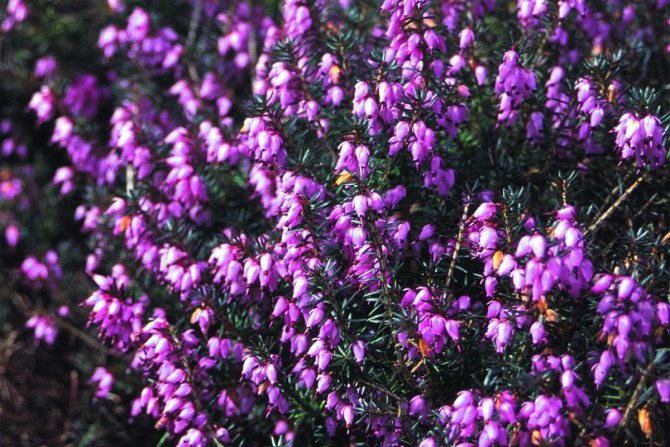Erica (Latin Erica) is a numerous genus of evergreen plants belonging to the Heather family. It has more than 850 shrubs and semi-shrubs, and there are trees. The bushes are compact, about 30 cm in height, and the trees can reach two meters. Absolutely all representatives are characterized by elongated linear leaf plates 2-15 mm long, they gather in whorls and densely cover the branches, they are very similar to needles (they have a special name - ericoid leaf). The shrubs have rigid, erect stems.
In terms of numbers, the genus Erica makes up 20% of the Heather family. The largest number of species live in South Africa, they are also distributed in the Mediterranean, along the islands of the Atlantic Ocean, in the Caucasus, and rare species live in Europe.
On the European continent, together with heather, erica forms heathers (heather wastelands). Inexperienced gardeners mistakenly believe that heather and erica are the same plant.
Erica is a relic plant, therefore it is of great importance in the educational process of students of biological faculties. The homeland of Erica is rightfully considered South Africa, and it was first domesticated in England (mid-18th century), then it became popular in Holland and Belgium. I came to our region in 1994 from Germany. At the moment, it is grown as a garden decoration, and even as a houseplant.
Planting a flower on the site
Erica is planted in a permanent place in the spring before or after flowering
... The place is chosen sheltered from drafts, well lit. Without direct sun, the color of leaves and flowers fades.
Erica prefers light, breathable, acidic soil. Therefore, peat and sand are introduced into the soil.
Eric's stagnant water can't stand
, it should be planted in places where there will be no heaps of melted snow in the spring. When planting potted crops, you need good drainage.
Plants are planted at a distance of 50 cm, keeping a planting density of 5-6 bushes per 1 sq. M. Planting depth - 20-25 cm, the root collar is not buried. For good rooting and growth, the first couple of months, the plants are watered in a day or two.
Eric's plant, cultivation features
- Most of the erica species (with the exception of forms that can grow in swampy areas) need well-water and air-permeable soil. The culture does not tolerate stagnant moisture, so when planting a plant (both in the garden and in a pot) it is important to build a good drainage layer.
- Erica responds positively to lightweight, loose soil. The best for planting is a soil mixture of peat, sand and sod land (3: 1: 1). For Erica species that prefer a neutral soil environment, it is necessary to reduce the amount of peat introduced into the mixture.
- Young plants are planted most often in early spring, before the flowering process. Planting is also practiced after flowering stops. If the transplant is carried out from a container, summer is also suitable. In this case, the pot is filled with water in advance and planted after 1-2 hours, preserving as much as possible a natural clod of earth (from the pot).
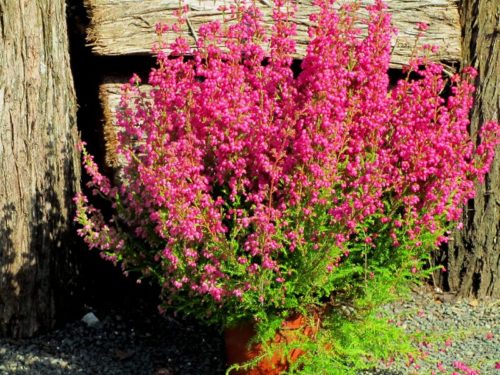
Erica planting a plant in the garden
- Numerous representatives of the Erica genus can grow on various types of soils: some on acidic, others on calcareous. The soil can be either dry sandy or wet, swampy.Therefore, before boarding, it is important to familiarize yourself with the preferences of this or that type of Erica. Most erica varieties still grow on neutral or acidic, drained soil.
- Evergreen culture negatively "refers" to organic fertilizers, so you should not "overdo it" with organic matter.
- The landing site should be chosen open, with diffused light. Shade and partial shade are undesirable, since such conditions provoke a faded color of perennial flowers and significantly reduce their abundance. Erect brittle branches of Erica need a site protected from winds and drafts. A hedge made of conifers (or other plants) will be a reliable protection for an ornamental shrub in the garden.
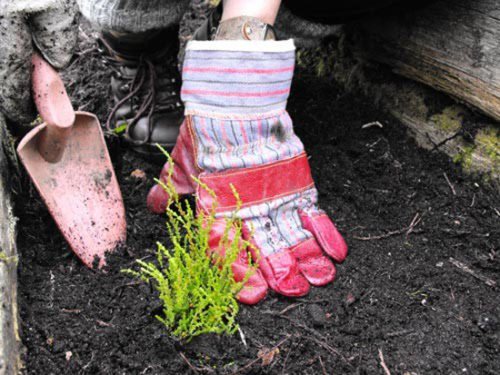

- To avoid permanent stagnation of moisture, it is better not to plant perennials in lowlands or hollows. Waterlogging provokes the development of fungal diseases.
- The initial stage of planting the culture will be the preparation of the planting pit. The depth of the hole should correspond to the size of the root system of the Erica seedling. As a rule, 20-25 cm will be sufficient.


- At the bottom of the pit, a drainage layer of crushed stone or broken brick is built, and soil mixture is poured on top. When planting, the root collar of the plant should be at ground level, without deepening.
- When planting several erika shrubs, a distance of about half a meter is left between them.
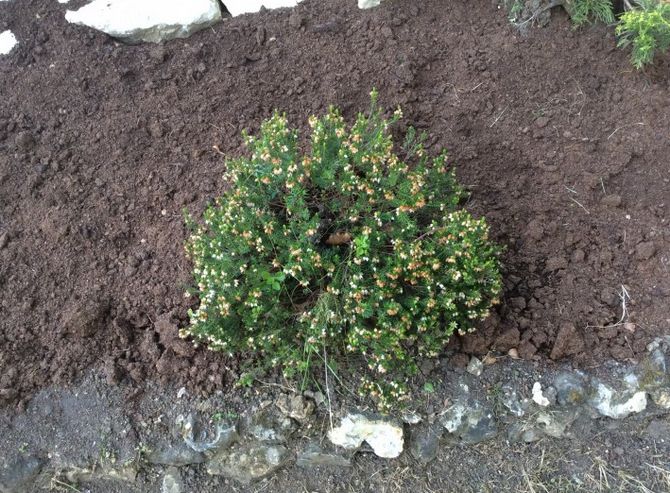

Erica planting a houseplant
- Growing a home plant, Erica, requires compliance with a certain temperature regime. The optimum temperature for cultivating a bush at home should not exceed 180C, and during the flowering period it should be even lower (up to 80C). In the case of temperatures exceeding the indicated indicators, the plant must necessarily increase the humidity of the air. To do this, the crown is sprayed from a spray bottle, a special humidifier is installed, or a flower pot is placed on wet expanded clay.
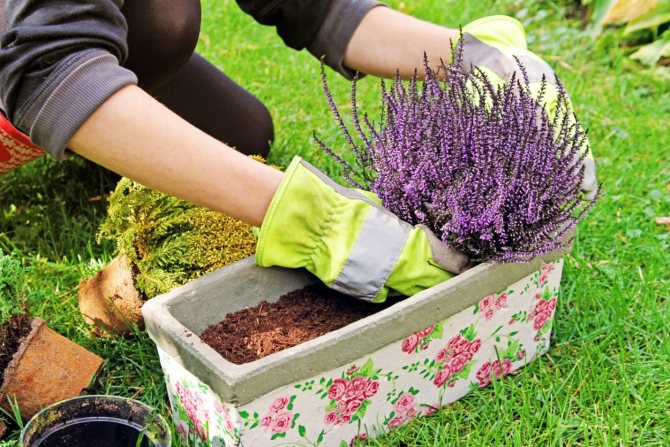

- When planting a plant in a pot, you must first make sure that there are several holes at the bottom of the planting container (for water drainage), then pour a drainage layer of fine gravel or expanded clay, and only then fill in the main soil mixture.
- The place where Ericu's houseplant is located should be well lit, without drafts.
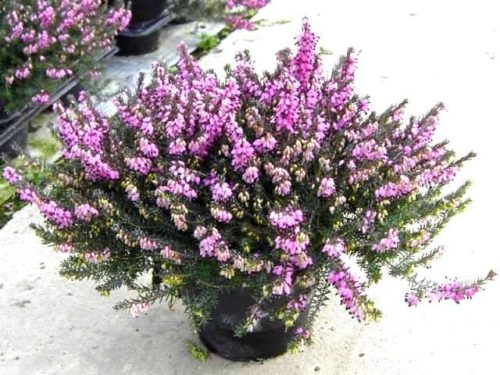

Where to buy and how to choose Eric's plant?
- When purchasing a coniferous plant, it is important to make sure of the identity of the selected variety, to check the plant's resistance to local climatic conditions. As you know, the zoned varieties are well adapted to the local climate, which cannot be said about the seedlings brought from afar or imported.
- When buying seedlings, you should pay attention to the condition of the root system of a representative of heather. Considering that Erica roots form a close symbiosis with soil fungi, damaged (bare) roots will not take root well in a new place.
- Erica sold in a container must also meet a number of requirements, namely: the shoots must be completely leafy and elastic; young (light colored) shoots will be visible at the ends of the branches; the soil in the container is moistened (without overdrying and moisture stagnation); the root ball of the container does not separate from the pot (this may indicate drying of the soil and roots).
- The best age for planting a seedling in a permanent place is 2-3 years.
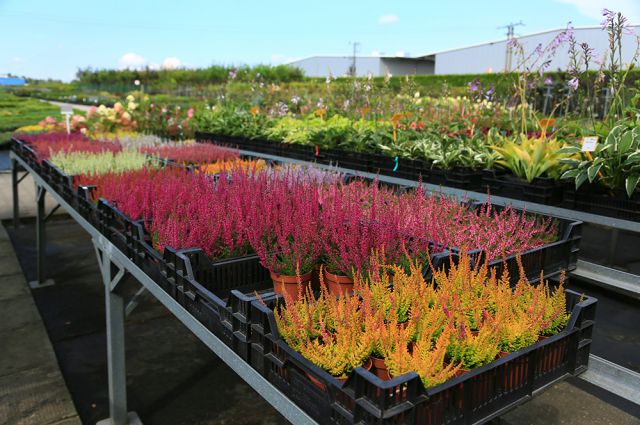

Care
Plant roots are shallow, therefore loosens the soil superficially
, to a depth of 6 cm.
You can mulch the soil with peat, pine needles, sawdust or bark with a layer of 5 cm. Mulch acidifies the soil, prevents weeds from growing, conserves moisture and ensures a safe winter.
Top dressing
Fertilize Erica when planting bushes, before flowering, and also after pruning. scattered under bushes or added to water when watering.They are fed with complex mineral fertilizers, such as Kemira-universal (20-30 g per 1 sq.m.), fertilizers for rhododendrons or azaleas, but in lower dosages.
Erika should not be fertilized with fresh organic matter.
Watering
Although Erica is drought tolerant crop
, drying out of the soil must not be allowed. Watered with warm soft water and sprayed over time.
Pruning
Pruning bushes provides rich flowering and improves bushiness
... Lignified branches do not form new shoots, therefore, after flowering, they cut off the part where the leaves grow.
The pruning is carried out asymmetrical - it gives the bushes a more attractive natural look.
Wintering
The trunk circles of the bushes are covered with a layer up to 10 cm
dry foliage or peat. Plants are covered with spruce branches: it protects from cold weather, prevents condensation and acidifies the soil with needles.
Erica's care
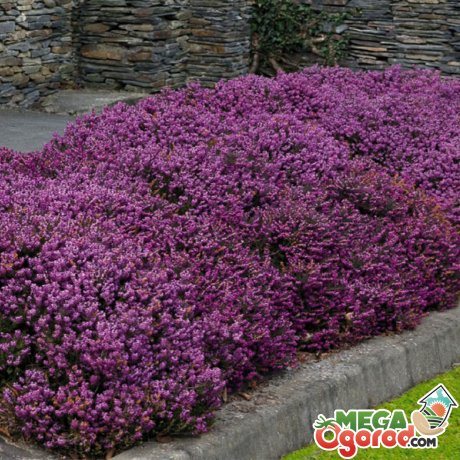

In order to maintain the intense color of the plant, it must be planted in sunny places. If Erica grows in partial shade, then her flowers will be pale and flowering is poor. The plant must be protected from the effects of the wind. For this purpose, hedges are very often planted.
For planting Erica, it is necessary to choose an almost neutral soil, but acidic soils are most suitable for her. That is why peat and sand are added to the soil before planting the plant.
Watering the plant:
- Only soft water should be used to water the plant.
- When watering a plant, the temperature regime is mandatory.
- From time to time, it is necessary to add various liquid fertilizers to the water.
- The terrestrial part of the erica should be sprayed periodically to maintain optimum moisture content.
- The soil around the plant must be constantly moist.
- When the plant dries up, it is watered abundantly.
- If Erica is grown in a pot, then it can be placed in water together with the pot for half an hour.
After wintering, the plant must be transplanted into another pot without fail, having previously prepared a new soil. It should be characterized by a large amount of peat, moderate acidity and the absence of lime impurities.
After transplanting the plant, the top layer of soil, which is located above the roots, is well compacted.
Erica's appearance plays an important role, so it also needs to be carefully monitored. After the plant has faded, dried flowers are removed from it. To do this, you just need to turn Erica on its side and russ the flowers.
Pruning a plant:
- This plant needs pruning after flowering.
- This action is performed to form bushes.
- Thanks to pruning, the plant will have a lush bush and abundant flowering for the next year.
- Only the green part of the plant, which is characterized by the presence of leaves, is cut off.
- This plant does not form new shoots in adulthood, so pruning is done in such a way as not to damage the lignified branches.
- To ensure the natural look of the bush, the pruning of the shoots is carried out at different levels. If it is produced symmetrically, the plant will lose its attractive appearance.
The plant is not very afraid of frost, but under the conditions of its cultivation in a harsh climate, it must be properly prepared for wintering. To do this, in the autumn period, peat or dry foliage is poured onto the near-stem circles of the plant. The upper part of the plant is covered with spruce branches, which allows it to be protected from frost, to limit moisture from condensation. Also, with the help of spruce branches, you can increase the acidity of the soil, which will favorably affect the growth and development of Erica.
Reproduction
By cuttings
With apical cuttings, Erica is propagated before flowering or a month after it.
Cuttings are cut 2-3 cm long and planted in an earthen mixture of 2 parts of peat and 1 part of sand, deepening 1/3 of the length into the ground.Sprinkle the soil on top with a layer of 1 cm.
Pots with cuttings are covered with polyethylene or glass, kept at a temperature 18-20 degrees
shading from the sun. Fertilize regularly with micronutrient fertilizers and a weak urea solution. After 3-4 weeks, the seedlings should take root.
Layers
In the spring they choose on the bushes strong shoots
, tilted to the loosened soil, attached with a wire or hairpin, covered with earth.
The soil is moistened, preventing drying out. When the shoots take root, they are carefully separated and planted.
Seeds
For sowing seeds, an earthen mixture is prepared from heather, coniferous soil and sand (in a ratio of 2: 1: 1). The seeds are small, they are not covered with earth, but only slightly pressed to the soil. The soil is moistened with a spray bottle, and high humidity is maintained for a week.
The container is covered with glass or polyethylene, the temperature is maintained at 18-20 ° C, and aired daily. Shoots will appear in a month.
Seed propagation laborious
, therefore, it is rarely used and mainly for natural plant varieties.
By dividing the bush
An old adult bush is dug up, divided with a knife or shovel into pieces and planted.
Vegetative propagation
Varieties and hybrids are best propagated vegetatively, since they can lose varietal differences during seed propagation.
Reproduction of Erica by cuttings
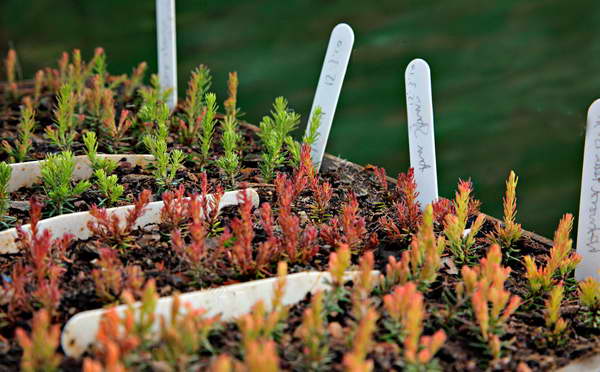

How to root Erica cuttings photo
The process itself is not complicated. It is best to cut the cuttings in late summer. Fill a box or container with a sand-peat mixture, plant the cuttings, deepening by 2-3 cm, cover the container with an oilcloth or transparent glass on top.
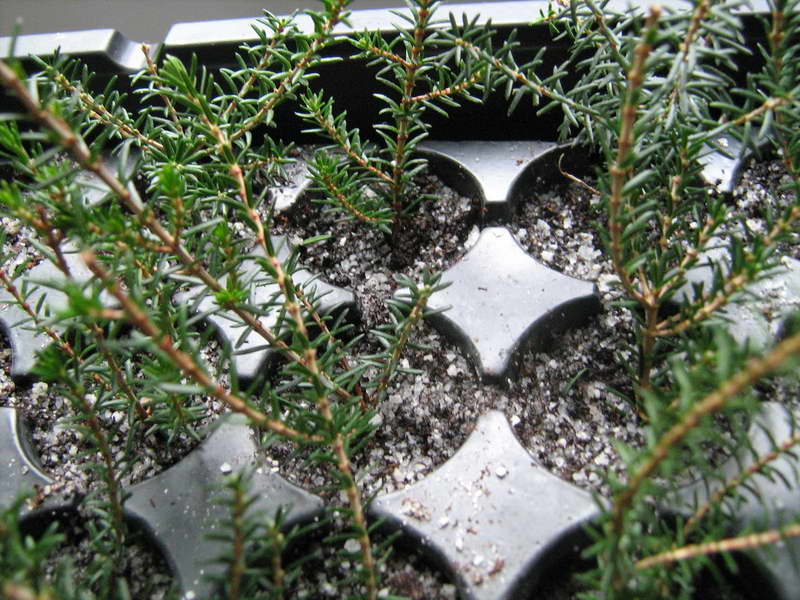

Cutting Erica photo
The air temperature and lighting are the same as when germinating seeds. They should stay in this position until spring, while raising the shelter for ventilation, and periodically moisten the soil. Plant rooted cuttings in separate pots or transplant them into open ground.
Reproduction of Erica by layering
In the spring, choose a healthy shoot, bend it to the ground, having previously made a small hole near the bush. Fix with a hairpin or wire, sprinkle with earth, and leave the top of the branch above the soil surface. Water and keep the soil constantly slightly damp and keep it dry. The next spring, the young plant can be separated from the mother bush and planted separately.
Diseases and pests
Fungal diseases:
- Gray rot
- a gray bloom appears on the branches, the plant sheds foliage, twigs partially die off. The reason is high humidity. - Powdery mildew
- young twigs dry up, and the plant is covered with a white-gray bloom. - Rust
- red-brown spots are formed on the leaves.
When Erica is damaged by gray rot, the twigs die off
Spraying with antifungal fungicides such as Topaz or Fundazol is recommended, and in severe cases - Bordeaux liquid or 1% copper sulfate solution. After 5-10 days, the treatment is repeated.
When viral
the disease, flowers and shoots are deformed, the color of buds and foliage changes. Unfortunately, there is no cure for this disease; the bushes will have to be dug up and burned.
On defeat scale insects and spider mites
on the bushes, a cotton-like bloom and cobweb appear on the underside of the leaves, the foliage is deformed and turns yellow. Treatment with fugincides is recommended, for example, "" or "Actellic"
Eric's plant, photo
Use of landscaping
Erica is used in single and group plantings, as a ground cover plant and as a pot culture for decorating verandas and windows.
Decorative and organic
Erica bushes look in company with barberry, heather, cereals, decorative ground covers, Japanese spirea, undersized conifers.
Erica branches are used to form a winter bouquet. The cut branches are dried in a vase. Flowers are sprayed with hairspray to prevent shedding.
Completely easy to care for, but surprisingly ornamental plant will decorate the garden and will delight with a palette of colors for most of the year.
From the very beginning of spring to late autumn, the amazing plant Erica, which is from South Africa, pleases with its exuberant long flowering, a variety of color palette, it has thoroughly won the hearts of gardeners in different parts of the world.
Eric's plant, botanical description
- Erica belongs to a large genus of ancient evergreens from the Heather family.
- The wide range of natural distribution of the genus from South Africa to the high mountains of the Caucasus is represented by more than 800 species of shrubs, trees and semi-shrubs. Numerous types of erica differ among themselves not only in appearance, but also in the requirements for the growing environment.
- An unusual, but very elegant name for the flower is associated with the Greek word "ereike", which means "to break". Most likely, this means the relationship with the brittle twigs of this coniferous plant.
- Most representatives of the Erica genus are represented by low-growing shrubs, from 20 cm to 2 m in height.
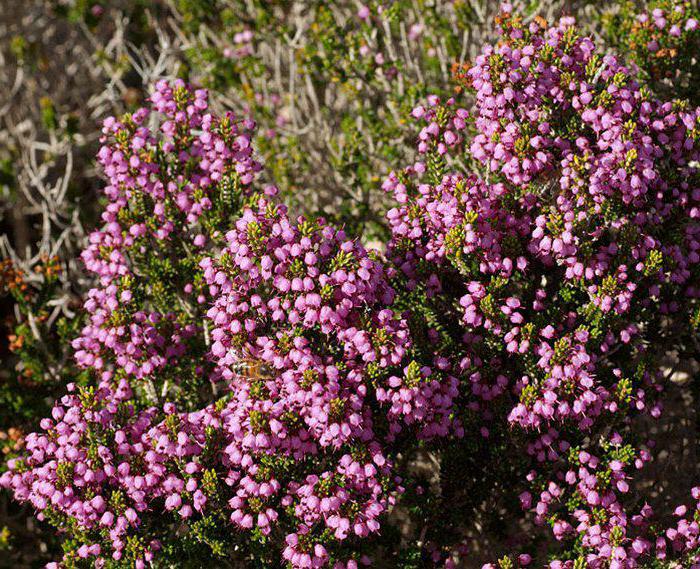

- Many types of erika are typical ornamental plants for the garden, although there are miniature forms that are recognized as purely indoor plants.
- Outwardly, Erica is very similar to common heather, but it has a brighter and more lush flowering.
- Lignified shoots of evergreen shrubs (and trees) are covered with gray or brown bark. Stems are thin, tough and erect.
- Narrow needle-shaped or linear leaves of a perennial crop are arranged in whorls or alternately. The length of the leaf blade can vary from 2 to 15 mm. The structure of erica leaves has its own characteristics: their edges are bent down, and on the lower side there is a hollow with stomata.
- Erika blooms in different ways (depending on the species), from spring to winter. It should be noted, however, that most of the representatives of the Erica genus are distinguished by a late flowering period. This feature of flowers has allowed the long-term culture to take pride of place among many landscape designers and interior decorators.
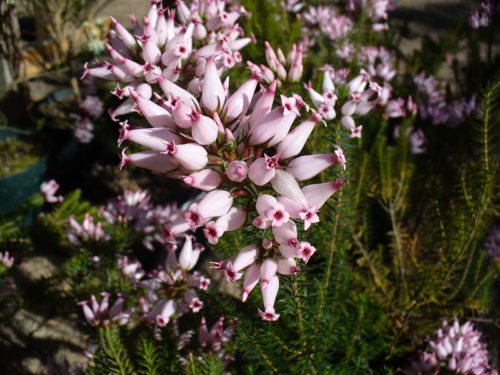

- Bell-shaped erica flowers are characterized by an elongated shape and sizes of about 1-3 cm. The color of the inflorescences is very diverse: from white to red, purple and ink.
- Faded dry inflorescences remain on the shoots for a long time, providing the plant with the effect of continuous flowering.
- The fruit looks like a tetrahedral capsule with many small seeds.
- Erica is a durable plant that can grow in one place for 15 to 20 years.


Eric's plant, scope of use
- Erika's evergreen heather is widely used in ornamental gardening and landscape design. Flowers look original and impressive against the background of recreation with stones, on flower beds, personal plots and city squares. Winter flowering erica species look rather unusual against the background of a dull winter landscape, especially since other plants in the garden are not capable of such competition at this time of year.
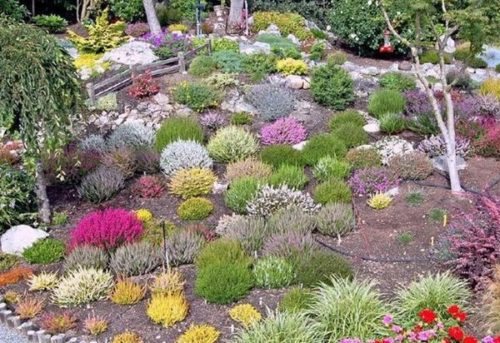

- The Erica plant is recognized as a real ancient relic that grows in the oldest ecosystem from the past geological eras. In connection with such a rich "past", the plant is studied in detail in a number of biological universities.
- Some types of erica are used medicinally as medicinal herbs to treat joint diseases (gout).
- Among the huge species diversity, many melliferous forms of the plant are known, thanks to which beekeepers obtain the so-called. "Heather honey".
- From the porous wood of the roots of the tree-like erica, smoking pipes are made, better known as "heather".
- There are also cultivated species that are excellent for cutting or making dry bouquets.
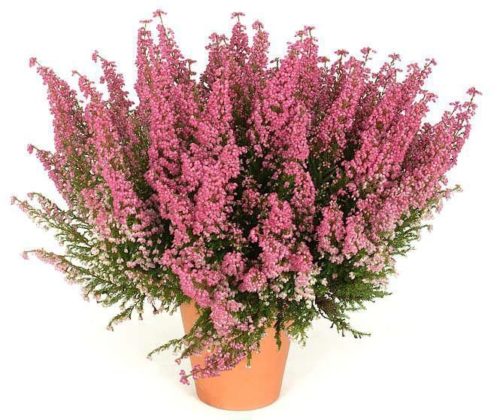

Description
Most erica species are evergreen shrubs that are very similar to heather. It is distinguished by narrow needle-like leaves up to 1 cm long, similar to needles, which grow at right angles to the shoot.During the flowering period, Erica is covered with numerous small flowers, reminiscent of elongated drooping bells. They are collected in large one-sided brushes and come in a wide variety of shades - from white to deep purple. After flowering, the color remains for a long time. The fruits are capsules with very small seeds that remain viable for several years.
In the role of natural types, Erica began to be used in England from the middle of the 18th century. Then, already in Belgium and Holland, almost a hundred years later, breeding work began, thanks to which many hybrids appeared. Today, the Erica plant, a description of some of which is given below, is grown both outdoors and in pots, decorating window sills and terraces. It is unpretentious and does not need special care.
Planting Erica in the open ground
Erika can be planted in open ground with the onset of relative warmth in spring, when the air temperature is set at + 10 ° C. This is the initial correct step in further successful cultivation.
If Erica is planted in open ground in the fall, the plant will not have time to take root and get stronger before the onset of winter. At best, young Erica will freeze, but most often the plant dies.
- Make planting holes 25-30 cm deep, length and width are also about 30 cm.
- Place a coarse sand drainage layer on the bottom.
- Place the seedling in the center of the hole and cover with a suitable substrate.
- Before planting, the seedling must be removed from the container and placed in warm water to saturate with moisture.
- After planting, the root collar should be flush with the soil surface.
- Water, let the water soak and immediately mulch the soil surface with sawdust, wood chips or peat.
Keep a 20-50 cm gap between individual plants. At least 5 plants must be used for a group planting to look good. They will become decorative (grow well) after 3 years.
Types of Erica
This plant is distinguished by a wide variety of species. Among them there are several gardeners that are distinguished by an increased interest in them:
- The very first to bloom is Erika herbaceous, or ruddy - already in April it is covered with pink or reddish bells. The height of this shrub is from 30 to 50 cm. Its outstretched stems, under favorable conditions, can form a pillow up to half a meter in diameter on the soil surface.
- Erica graceful is cultivated mainly as a pot plant. Flowering begins in November and lasts for several months. There are several varieties of Erika graceful - with white, pink and reddish flowers.
- Erica Darlenskaya plant is a hybrid created by English breeder Darley Dale in the early twentieth century. Today it is widespread in Russia. Differs in high winter hardiness and abundant long flowering. There are more than 20 varieties of this species, the tallest of which reaches a height of 50 cm.
- The Erica pink plant is one of the smallest species. Its height rarely exceeds 20 cm. Dark red flowers appear in April.
All species of this plant are propagated by seed or cuttings. Seedlings can be transplanted to a permanent place no earlier than after 1.5-2 years.
Types of Erica with photos and names
Despite the large number of erica species, gardeners focus on a few basic ones that can be easily grown at home. They all vary in size and color.
Erica ruddy or grassy Erica herbacea or Erica carnea
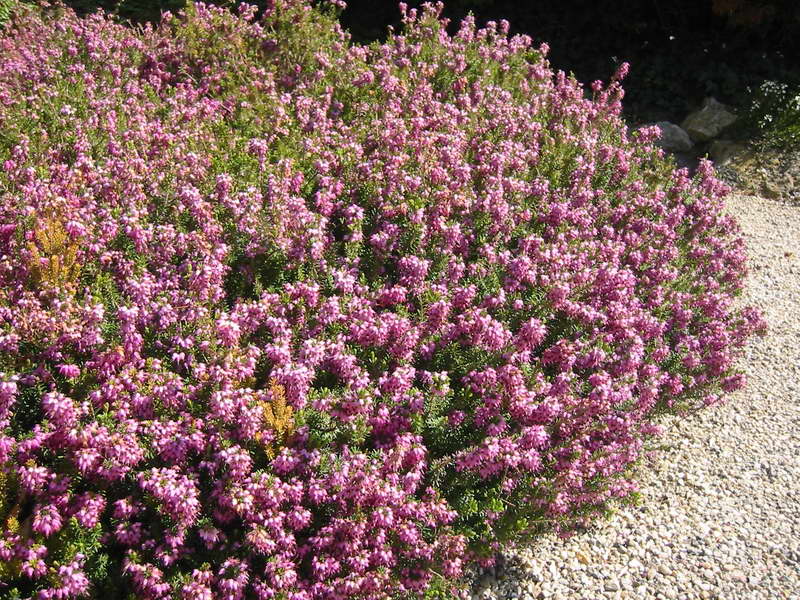

Erica ruddy or grassy Erica herbacea or Erica carnea photo
The flowering period lasts from November to April. In the natural environment, it is most often found in Central and Southern Europe. The height of the shrub reaches 65 cm, and in width it grows by 45 cm. It branches well, the shoots are densely covered with needle-like leaf plates 4-8 mm long.The leaves are collected in whorls of 4 pieces. Inflorescences grow in the leaf axils. Corollas are bell-shaped, drooping, pink, red, less often white.
Erica graceful Erica gracilis
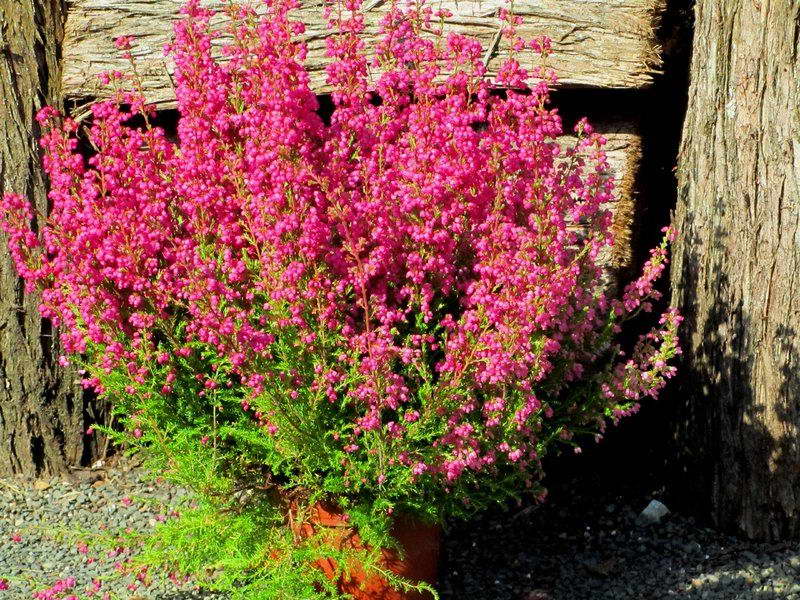

Erica graceful Erica gracilis photo
Half-meter high bush. It has an uneven crown: the central shoots are longer than the lateral ones. Linear leaves only 4 mm long, light green. Oval corollas are collected in inflorescences of 4 pcs. on the tops of the shoots. The shade of the flowers is bright red. In varietal plants, flowers can be snow-white, pink. This species tolerates only light night frosts, therefore it is grown as an annual or in a pot. Vegetative reproduction (rooting of cuttings). It is preferable to grow in a shady secluded place. Suitable partners on the site will be cyclamens, stonecrops, chrysanthemums.
Erica x darleyensis
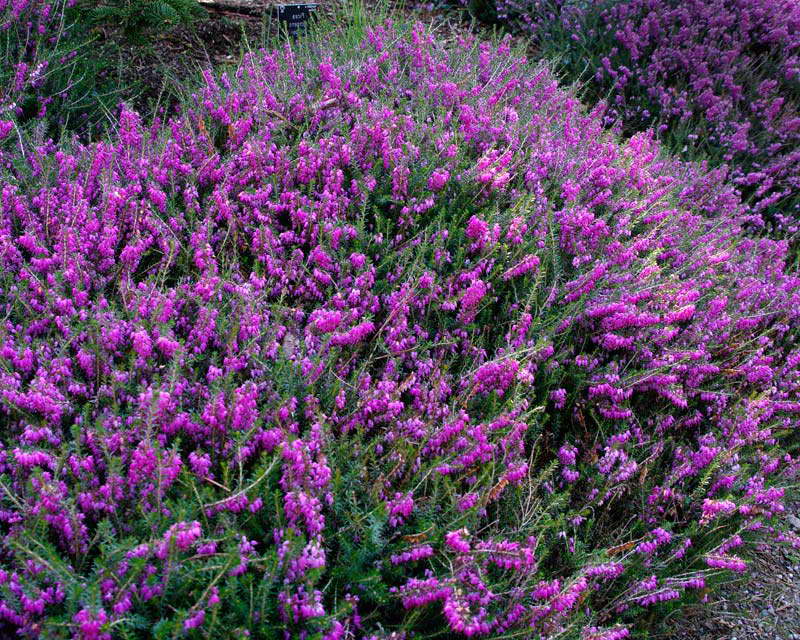

Erica darlenskaya Erica x darleyensis photo
A hybrid that begins flowering in April or early May. The shrub is highly branching, in the natural environment it reaches a height of 0.9 m, during cultivation it is limited to a half-meter mark. It is notable for its rapid growth rates, which is why it has found particular popularity among gardeners. The flowers are snow-white, pink, bright crimson (depending on the variety). For cultivation, you will need an area illuminated by the bright sun and protected from strong winds. Not all varieties are frost-resistant, grown as a summer or pot crop.
Erica tetralix
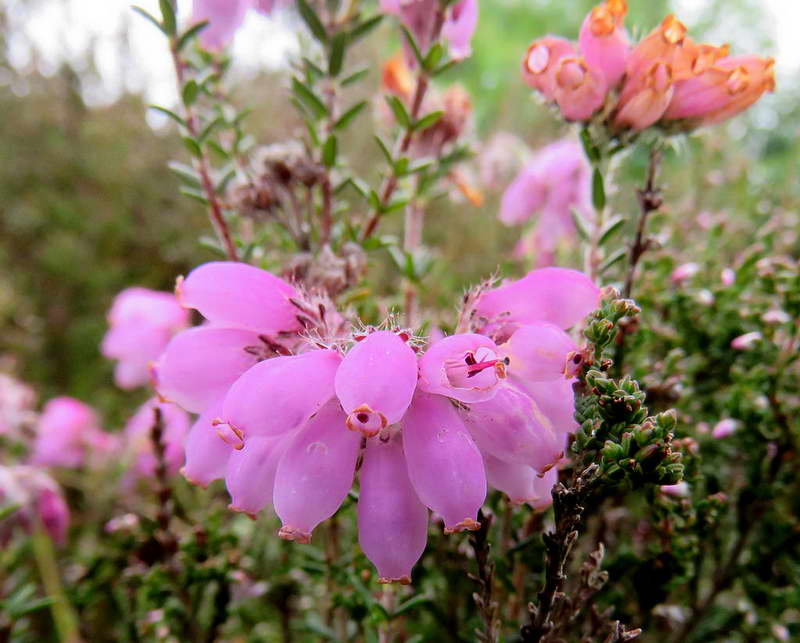

Erica four-dimensional or cruciferous Erica tetralix photo
A species that can successfully winter in conditions of central Russia in the presence of a shelter (winter hardiness zone 4-5). When planting next to conifers, it can do without additional shelter. The bush is compact, the stems are erect, stretching 0.5-0.7 m in length. When planted on well-drained moist soil, the acid reaction grows quickly. The leaves are green with a bluish tint, there is a tomentose pubescence. Blooms in summer to late autumn. The flowers are white, pale pink or red.
Erica arborea


Erica arborea photo
A pretty thermophilic tree no more than 3 m high. In the conditions of its natural environment, it lives in the Mediterranean. The gardener liked the tree so much that in our regions it is grown in containers. During the warm season, it can be used as a mobile decoration of a garden, balcony, loggia, gazebo, and with the onset of cold weather, it must be transferred to a winter garden. Flowers in the form of bells, looking down, snow-white with anthers of a red-brown hue, very fragrant, collected in a racemose inflorescence.
Erica spiculate Erica spiculifolia
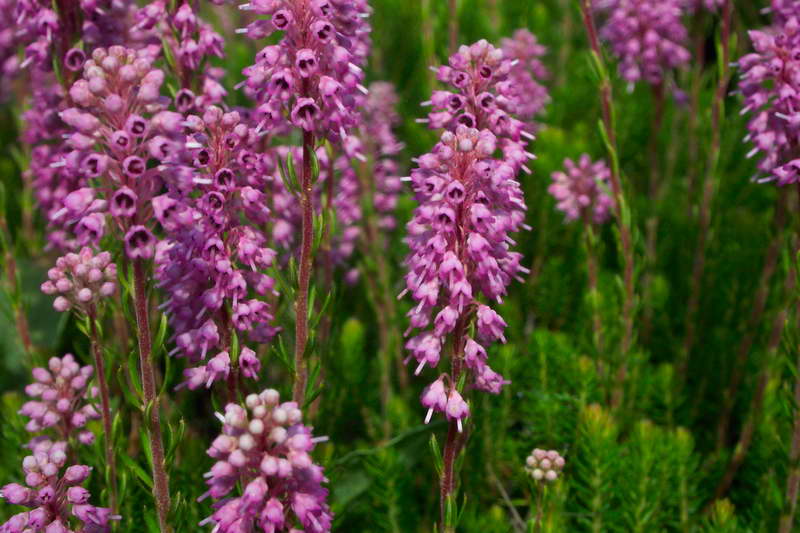

Erica spiculata Erica spiculifolia photo
It is a low (about 25 cm) spreading semi-shrub. Oblong leaves of a dark green color are strewn with stems. The flowering period is June-July. The most delicate bell-shaped corollas have a pale pink hue. Withstands a drop in temperature to -23 ° C, successfully overwinters under a snow cover, but it is better to build a shelter. The plant previously belonged to a genus close to Eric: Bruckenthalia.
The most demanded variety is Balkan Rose, which is much superior in decorativeness to both the species and other varietal plants.
Erica gray or gray Erica cinerea
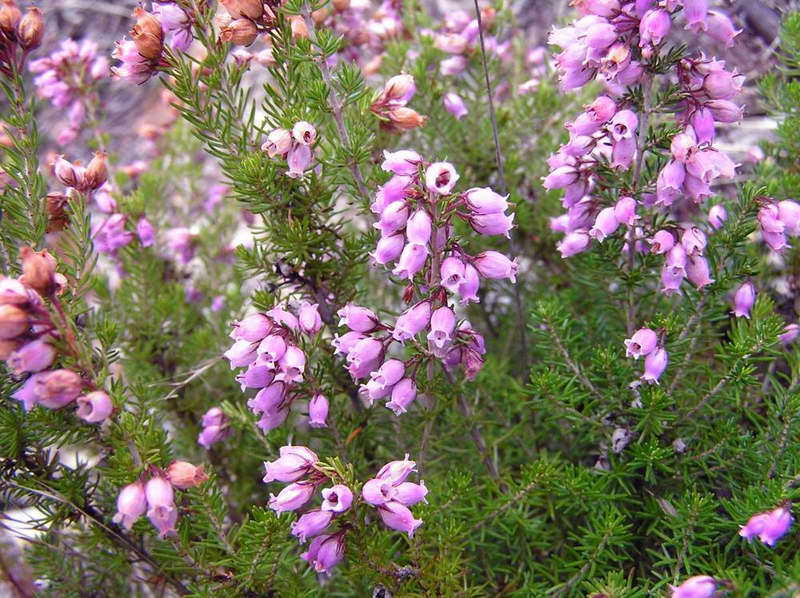

Erica gray or gray Erica cinerea photo
Sprawling bushes 20-50 cm high. The flowering period lasts all summer, retreating with the autumn cold. Winter hardiness zone 4-5 (up to -34 ° C). Still, it is better to cover the plantings for the winter.
Seed propagation
This method is rather laborious and is recommended mainly for planting natural types of erica. Seeds are sown on prepared soil, consisting of coniferous, heather earth and sand (in a ratio of 1: 2: 1, respectively) and covered with glass or plastic wrap. In this case, the temperature must be at least 18 ⁰С. Every day the soil with seeds is sprayed with warm water. The seed germination process is quite long and takes at least 1 month. As soon as the shoots appear and grow a little, they are dived and gradually accustomed to sunlight. In order to get stronger, the seedlings will need another 2 months.
Erica plant propagation
Perennial Erica reproduces by seeds, cuttings, layering or dividing the bush.
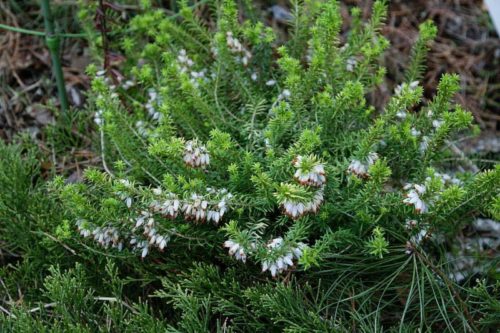

Generative method (by seeds) of reproduction of Erica
This breeding method is most often used when developing new varieties of Erica. It is also practiced to breed Erica with seeds and at home, although it will take more time to grow seedlings than with the vegetative method.
- Erica seeds are very small, therefore, surface sowing is used for them, they can also be sown in bags (or bowls) without embedding in the ground. Coniferous soil, peat and sand (1: 2: 1) are used as a substrate. The bowls are covered with glass, simulating the conditions of a greenhouse.
- Maintaining a temperature regime of about 200C, providing moistening of the soil and airing the greenhouse, plant shoots appear in about a month.
- The seedlings are provided with light and moisture, they are grown and hardened, and only after 1.5-2 years they will be ready for planting in a permanent place.
- Erika seeds, under proper storage conditions, are capable of maintaining germination for a long time (up to 15 years).
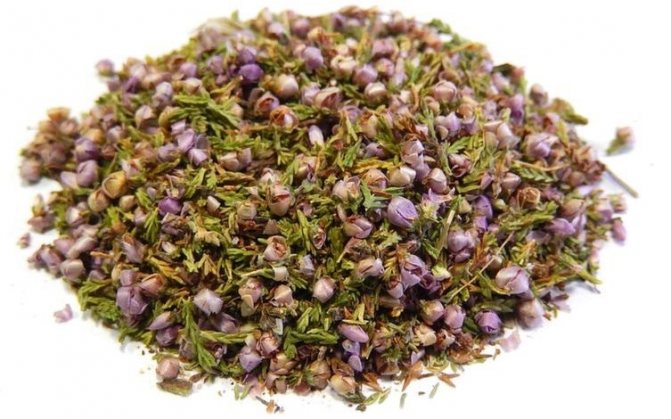

Vegetative method (cuttings, part of the bush, layering) reproduction of Erica
- For propagation by cuttings, in early spring (or after the flowering period), short semi-lignified apical shoots of Erica are cut off, about 2-3 cm long. Cuttings are deepened by a third into a substrate of peat and sand. Good results of rooting cuttings are shown by the use of additional dressings (micronutrient fertilizers or a weak urea solution). After about a month, the cuttings will form roots. From this time on, the cuttings grow rapidly and are planted in a permanent place.
- Dividing the shrub into parts is perhaps the easiest way to propagate evergreen heather. To do this, the bush, with the help of a shovel, is divided into parts with full-fledged roots, after which they are seated in a new place.
- Shrub cuttings (lower shoots) are added dropwise in the spring, pinched with a staple and the formation of roots is awaited. Naturally, during this period, the plant and the place where the layers are fixed need regular watering. Rooted layers are separated from the mother bush and planted separately.


So, a surprisingly attractive plant, Erica, is most often used in horticultural floriculture, but some of its species can also be grown at home, in flower pots. At the same time, it is important to take into account the peculiarities of the cultivation of an evergreen shrub and its basic needs: light, moisture, fresh air.
Knowing the key agricultural techniques, planting and caring for an Erica plant will not cause any particular difficulties. Instead, a flower bed, flower pot or garden will truly transform and "sparkle" with multi-colored paints, even in the cold season.
Propagation by cuttings
Plants grown in this way begin to bloom much earlier than those planted with seeds. Planting material is harvested in the fall, cutting off the tops of lignified shoots. Pre-soaked in a growth stimulator, the cuttings are planted in a substrate consisting of a mixture of peat and sand. Before that, it is recommended to spray them with water. The soil should be sufficiently moist and loose, and the temperature should be in the range of 18-20 С. Planting should be protected from direct sunlight.
After about 3 months, the cuttings take root. Now you can start gradually exposing them to the sun and fresh air. This hardening period lasts for a month. Only then can the young Eric's plant be planted in the garden.
Growing Erica from seeds
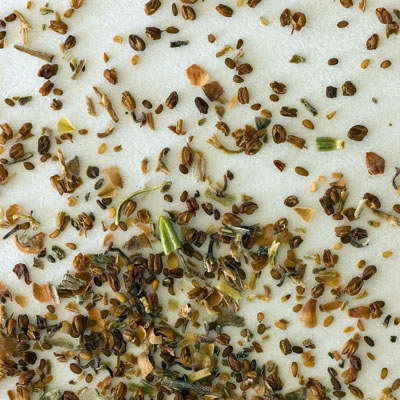

Erica seeds photo
Generative (seed) reproduction of Erica involves growing seedlings. Sow seeds for seedlings in the spring. Prepare a potting mix of equal proportions of sand and peat.
- Fill a wide container with the substrate and spread the seeds over the soil surface (they are small, so they should not be buried).
- Spray crops from a fine-dispersed sprayer, further moisten the soil in the same way so that the seeds do not "drown".
- To create the effect of a greenhouse, cover the box with crops on top with glass or foil, but raise the shelter daily for ventilation.
- Lighting should be diffused, keep the air temperature within 18-20 ° C.
- Seedlings will appear after 3-4 weeks, then the shelter can be removed.
- When the sprouts reach a height of 8-10 cm, they must be planted in individual pots. They are not transplanted into open ground until next year.
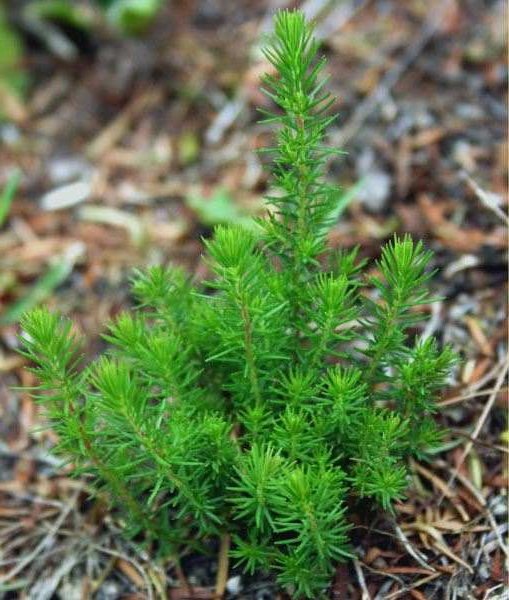

Erica from the seed
During the warm season, the seedlings can be taken out into the garden, and they should winter in a room with an air temperature of 10-12 ° C.
Choosing a landing site
It should be noted that in nature, plants grow only on air-permeable soils. Without providing good drainage, they simply will not develop fully. The plant does not tolerate stagnant water. When choosing a landing site, avoid areas where there is an accumulation of melted snow. In order to maintain the bright color of the leaves and flowers, Erica needs a sufficient amount of sun. Do not plant it in shaded and windy areas. Erica is a plant, planting and caring for which is not difficult if the place for it is chosen correctly.
Growing
Caring for Erica is not particularly difficult. So that the plant does not die and for a long time (Eriks live up to 30 years) pleases with its delicate flowering, a number of non-burdensome conditions must be observed.
For Erica, it is very important that even short-term overdrying of the roots is not allowed. Therefore, the soil must be constantly moist, loose, hygroscopic, with good drainage. It is necessary to maintain a delicate balance in watering and prevent roots from sticking.
Spraying with soft water at room temperature has a beneficial effect on the condition of the plant. You rarely need to feed Eric, usually in the spring.
Care features
Erica prefers slightly acidic or neutral soil. If you add a little river sand to it, then the plants will feel great for many years. Growing Erica is within the power of even a novice gardener. All this plant needs is to ensure timely watering, feeding and pruning the shoots when flowering ends.
Erica is a plant that home care also includes preparing for the winter. Before the onset of the first frosts, it is necessary to moisten and mulch the soil, and cover the plantations with dry foliage or spruce branches. Mulch will not only provide the plant with good wintering, but will also enrich the soil with useful substances.
Success secrets
A prerequisite for the well-being of a plant during transplantation is its transshipment into a larger container while preserving the earthen coma and the established microflora. Excess soil after transplanting Erica can be added to the soil for Azaleas, Camellias, Saintpaulias. This will have a beneficial effect on their growth.
Erica does not tolerate the presence of lime in the soil and water. Therefore, it must be watered and sprayed with soft, settled water and make sure that there is no calcium in the fertilizer. Acidifying the soil with citric acid and lemon juice diluted in water is beneficial for Erica.
It is advisable to feed the plant only with mineral fertilizers. It is good to use ready-made fertilizers for Azaleas. Organics must be completely excluded from her diet. This is a general condition for all Heathers.
Pruning
This procedure, mandatory to maintain a decorative appearance, is performed immediately after the flowering of erica. It allows you to form a beautiful and regular bush. In addition, pruning allows for more lush and more abundant flowering in the next season.
Only the green part of the shoot, which has leaves, should be removed. Experts recommend asymmetrical pruning - it allows you to preserve the natural appearance of the plant and give a more attractive appearance.
Flowering and species
Erika herbaceous or ruddy (Eríca cárnea) and Darleys (Erica x darleyensis) bloom earlier than anyone else in late winter and early spring. Flowering continues until the end of April. In the second half of June and until the end of August, the flowering time of the four-dimensional erica (Erica tetralix), which prefers moist and ash soil (Erica cinerea), begins. Erica vagans blooms in August-September with pink, white or cream flowers, can reach 75 cm in height.
Erica Darleys is a hybrid obtained in the early twentieth century by the English breeder Darley Dale by crossing Erica ruddy. The popular variety "Kramers mouth" grows up to 50 cm in height and is one of the tallest varieties of this species. Grows rapidly, creating large clumps.
Small, green, needle-like leaves are densely packed around the shoot. From late February - early March, as soon as the frosts subsided and the snow melted, ruby-red flowers appear on the raised stems on the bushes. It blooms at relatively low temperatures, so bloom can last until May. Shelter is required during winter.
Erica herbaceous is the most popular in the culture. Very hardy, tolerant of most soils and the most frost resistant of all cultivated species. It is a low-growing (10-25 cm) spreading shrub. Thanks to selection, more than 100 cultivars and hybrid forms of high decorativeness were obtained. Some famous varieties: Golden Star, Ice Princess, Myretoun Ruby, Natalie, Pink Spangle, Sunshine Ramble, Jenny Porter, etc.
Erica ash is cultivated in a wide range of colors. The height of the bushes is 15-60 cm. It hibernates under cover. Decorative varieties: "C.D. Eason ”,“ Pink Ice ”,“ Velvet Night ”.
Diseases and pests
The most common diseases inherent in this plant are caused by fungal and viral infections. Among them, gray rot is most common. The cause of its development is usually high humidity. The first signs of the disease are gray bloom, leaf fall and the death of young shoots. Today there are enough different antifungal insecticides to help cope with gray mold: "Fendazol", "Topaz". For very serious rot injuries, spraying with a 1% solution of copper sulfate is recommended. Treatment of diseased plants is carried out twice with an interval of 5-10 days.
For prophylactic purposes, spraying is carried out in the autumn-spring periods, using the above-mentioned drugs for this.
As for insect pests, their plant is practically not interested in Eric. Occasionally you can find bugs and ticks on it. Treatment of the stems and leaves of the plant with an alcohol solution, which is applied with a brush, is effective against them. Then the areas affected by pests are additionally treated with special agents called "Actellik" and "Fitoverm".
Erica in the garden
The perennial's colorful palette and appearance make it a popular plant in garden design. Shrubs planted in large groups produce a microclimate that is conducive to their development. Perennial looks great in combination with heather, undersized, cereals, Japanese, and decorative. The culture is great for creating rockeries and.
Compositions of different varietal forms with heather will allow you to get a stable play of shape and color throughout the season. Spectacular intense ruby "Kramers mouth" is planted in irregular groups or on talus, where it forms a pronounced color accent.
Application in landscape design
Erica, thanks to her late flowering, is a real find for gardeners who create rock gardens, rockeries and flower beds. Landscape designers often use it as a ground cover. In addition, blooming Erica looks great both in mono compositions and in group plantings.
The plant in the garden creates a special microclimate that contributes to the development of other crops - heather, cereals, barberry.With such neighbors, Erica looks especially attractive.
For many years this plant has been a recognized decoration of the garden.
In Europe, herbal erica (many flower growers also call her “herb erika”) is a recognized plant in decorating and creating a background for rock gardens and flower gardens. In Russia, they are little known, and also very few people are grown.
There is one nuance and a definite plus in her breeding - she begins to bloom when most garden plants and flowers cannot afford it - namely, in late autumn or early winter.
But one question immediately suggests itself - after all, the climate in Europe is milder - whether it will be able to grow here, in Russian gardens and flower gardens. Let's answer - maybe it even feels great if several conditions for caring for this wonderful (or rather wonderful) plant are met.
One thing is that herbal Erica will not be able to bloom throughout Russia in winter, but in the South of Russia - please. The rest will have to be content with its flowering in late April-early May, and in the warm winter, herbal Erica can bloom in your garden even in late March-early April.
As for this property of herbaceous erica as "evergreen", it is preserved everywhere, which is a big and important plus for many gardeners and florists who hate the fading of a garden and a flower garden.
Erica's description
Caring for a plant is in many ways similar to cultivation and in appearance they are also very similar, however, you can see some differences up close. Heather has scaly leaves growing at an angle on the stem, while Erica has needle-like leaves growing at right angles to the shoots.
The flowers are bell-shaped, starting with white and ending with a dark red or purple hue, after flowering they do not lose their decorative effect, since they retain their color for a very long time. In some species, they are embedded in the leaf axils along the entire length of the shoot, while in others they are located at the top of the stems, collected in brushes. The seeds are very small, in some species they can survive in the soil for decades.
At least 660 members of the genus are endemic to South Africa. The rest grow in other parts of Africa, Madagascar, the Mediterranean, Turkey, and the Caucasus.
Erica herbal - care
It is easy and not difficult to care for the Erica plant.
It grows very quickly, on the basis of which many use it as a ground cover, for example, in the west, lawns of ground cover plants are not rare in which Erica herbal also takes part in her feasible part.
Despite the fact that in mono compositions it is also often used (mainly for framing flower beds), especially herbaceous erica is effective in group plantings - in them you can see her from afar.
In the South of Russia, Erika herbaceous will bloom when other plants, both trees and shrubs, have already shed their leaves. Therefore, it is so important to choose neighbors for herbal Erica.
First of all, look from among the ornamental grasses (of which bearded feather grass, fescue are suitable). Also, next to Erica, dwarf cedar, small pine, juniper and other dwarf shrubs and trees, including coniferous dwarfs, will look good.
Since Erica herself is a herbal representative of the heather family, you can also look for neighbors for her from other representatives of this species.
So frosts, for example, are tolerated not only by one erica herbal - from heather, using their this property, you can plant next to her Erica Darliens
, erica four-dimensional, and the most ordinary heather. They will endure the frost together.
The rest of the heather are winter-hardy only conditionally - these are:
- Erica verticulata (E. verticillata),
- Erika vagans
- Erica arborea
- Erika cinerea
Erica: growing, caring
In the garden Erica
conditions should be created as close as possible to the natural habitat of this species. The most common growing conditions for heathers are acidic soil and plenty of moisture. The exception to the first rule is only some modern hybrids.
Erica
able to tolerate neutral or even slightly alkaline soil. Soil moisture is especially important for young, rooting plants. Wherein
Erica
excellent permeability of the soil is required, since only those species that grow in nature on swampy wastelands can tolerate water stagnation.
Growing conditions Erica
identical to the growing conditions for common heather. Read in detail about
the cultivation, care, reproduction and diseases and use of common heather in garden design
by this link.
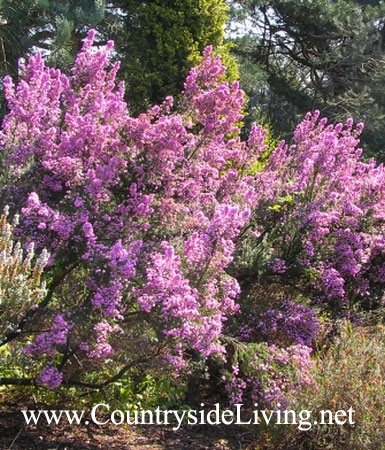

Erika
suitable for cutting and for dry winter bouquets. When preparing branches
Erica
with inflorescences for a winter bouquet, dry them carefully, right in a decorative container, where they will continue to be. To the dried flowers
Erica
with flowers did not crumble, lightly sprinkle them with hairspray.
Material and pictures: Oksana Jeter, website
The article is partially based on material from my article on Eric, Heather, Dabecia and Podbele "Heather - the pride of Scotland", published in the magazine "Flowers" for November 2005
Erica belongs to the common Heather family (Ericaceae). The genus, which is very numerous and decorative during the flowering period, numbers, according to various sources, 500-700 species. In natural conditions, some species grow up to 2 meters. African representatives have larger flowers and leaves. The same types of Erica that are used in indoor floriculture are more compact and decorative.
Erica is an evergreen relict shrub that has inhabited vast wastelands, peat bogs and mountain slopes unsuitable for other plants since the Neolithic. Of particular interest is the peculiar symbiosis of Heathers with the simplest fungi, which help the roots to produce mycorrhiza. Thanks to her, the plant can extract nutrients from poor soils. Erica's seeds will germinate only in the so-called heather soil, which is formed as a result of the vital activity of the plant and in the presence of these fungi.
Most of Erica's species bloom in winter, when many plants are resting, and this is one of its significant advantages.
Erica's flowers are small, bell-shaped with separate or accrete petals. They can be from a few millimeters to 1.5–2 cm in size, simple and terry in shape. Many flowers, collected in large and very decorative apical inflorescences, look very impressive.
All shades of red, pink, lilac are present in the colors. Snow-white inflorescences look very beautiful.
The plant does not lose its bright appearance even after the end of flowering. Its inflorescences retain their decorative effect for several months and, as a dried flower, can decorate the interior for a long time.
The richness of colors, flower shapes and a long flowering period make Erica a welcome guest on our windowsills.
Flowering occurs on young shoots. To stimulate it, as well as the formation of bushes of the desired shape and size, after the end of flowering, formative pruning is performed.
Small, needle-like leaves of the plant are very reminiscent of needles and have absorbed all shades of green.
An interesting feature in some species is the change in foliage color in winter.
Heather Erica landing and leaving. Erica plant description
Erica is a small, beautiful evergreen shrub with narrow needle-like leaves visible. Erica can be seen blooming in summer and winter. If the place of its growth is cold regions, then flowering occurs in spring and autumn. Since dried flowers do not fall off for a very long time, it seems that flowering lasts for six months.
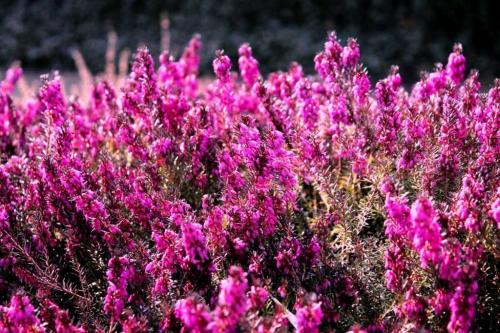

The very name Erica is rooted in Ancient Greece and means "to break" (ereiko).Ancient people believed that if you insist on Erica leaves in a special way and drink liquid, you can break kidney stones, and then they will come out on their own. Some people generalize Erica with heather. But botanists argue that this is not true, although it can be quite difficult to distinguish common heather from erica. To do this, you need to have special knowledge in the field of crop production.
Erica can grow in the form of a shrub, shrub or tree with leaves that look like needles. When flowering, Erica is covered with a large number of small white or pink flowers. The flowers form dense clusters and resemble drooping bells.
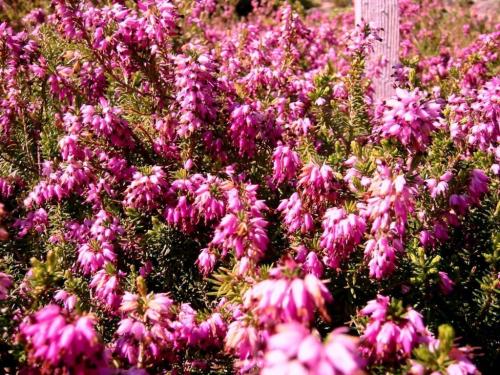

There is practically no place where Erica cannot be found: it grows in Europe, Turkey, in Africa, where there is a temperate climate. But most often it can be found in the Cape Province (South Africa). Who was in Scotland, could not help but see the massive thickets of this plant on the mountain slopes, vast wastelands and peat bogs.
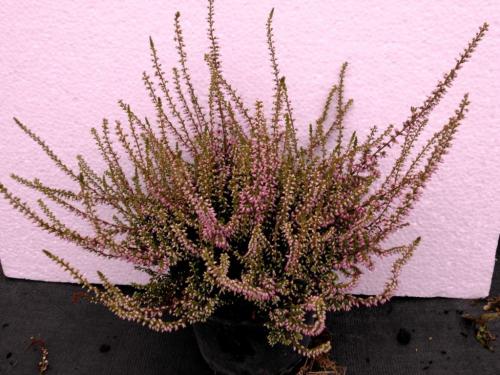

Varieties
The genus Erica has over 600 species. They have significant differences among themselves: in the size and shape of the bush, the shade of flowers and leaves, unpretentiousness to the environment (some prefer swampy wastelands, while others prefer dry heaths). On some bushes of this plant, the color of the leaves changes in winter. For the most part, Erica is a winter-flowering shrub, and only a few of them throw out flowers on warm summer days. Let's take a closer look at the most common varieties of this beautiful shrub.
- Herbal Erica (carnea Erica). It is also called "ruddy". It is an evergreen shrub with a lush crown. It reaches a height of up to half a meter. Some peoples also call it “winter heather”. When Erica is planted in southern latitudes, then he can throw out flowers in winter, therefore, the preferred territory for him is the middle zone of Russia. This plant alone includes about 200 varieties. It can be grown by analogy with a ground cover, because as soon as it grows, it will cover the earth with a living carpet. It is customary to decorate alpine slides or heather gardens with Erica. The branches of this plant extend in different directions, and the shoots are bare, only covered with dark gray bark. The leaves are painted in a bright green hue, have a linear elongated shape, grow in four pieces, up to one centimeter long. The leaves that grow at the bottom of the bush and are the oldest ones acquire a reddish color in autumn. When flowering occurs, the bush is decorated with pink - red buds, sometimes you can see a white shade. Flowers look like drooping bells. The buds are located in the axils of the leaf plates, from two to four pieces, which are then transformed into inflorescence brushes. Erika's flowering period is from mid-spring to mid-summer, depending on the place of planting. As for the southern regions, you can admire the flowers already in March.
What to choose?
It would seem that this question has an unambiguous answer, if there is a place, then it is better to have both heather crops in the garden. Due to similar requirements for growing conditions, they can be planted in small clumps in the neighborhood, which, due to different flowering periods, successfully complement each other.
But if you have to make a choice between two cultures, then according to gardeners' reviews, heather is a more unpretentious culture that takes root well in the garden. But the cultivation of Erica often turns out to be a failure, although it would seem that all the necessary agrotechnical techniques were followed.
Most likely, this is due to the fact that in supermarkets one of the types of erika most often comes across, which hibernates poorly in the middle lane, but among heathers there are also often low-hardy varieties.
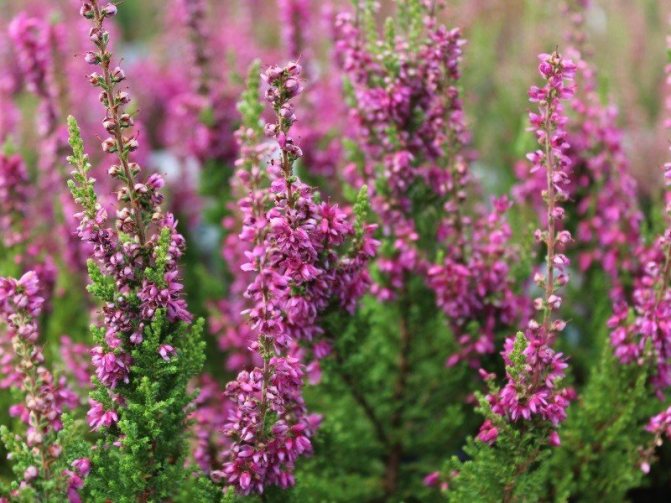

Common heather "Dark Beauty" (Calluna vulgaris ‘Dark Beauty’). <>
Erica - home care
If you grow Erica indoors, it is advisable to take her out to the balcony or loggia more often.The plant is very fond of good light, and also needs fresh air. Pruning is an important prerequisite for caring for Erica. Shoots are pinched or pruned, not only to stimulate the growth and bushiness of Erica, but also to give the bush a decorative, neat shape. From time to time, faded "bells" are removed from the plant by shaking off.
Video - Erica pink, evergreen low shrub.
Watering Erica is rarely watered in winter. In the summer months, when the plant blooms profusely, and its shoots lengthen very quickly, you should ensure good regular watering. But it is impossible to allow stagnation of moisture in the soil.
Temperature Sudden jumps in temperature are detrimental to Erica. The plant is very thermophilic and does not tolerate drafts, cold winds. In winter, it is best to place it on the windowsills above the heating radiators, while ensuring sufficient humidity.
Top dressing Fertilize the plant very carefully. Organic matter for feeding is not suitable - it can "burn" the shoots and stems. It is best to use store-bought mineral formulations that are diluted less than recommended on the packaging. Fertilize the soil just before flowering.
Transfer Erika needs to be repotted at the end of each winter. At the same time, after removing the plant from the pot, it is placed in a jar or other vessel with water for 1-2 hours, after which it is planted in fresh peaty soil.
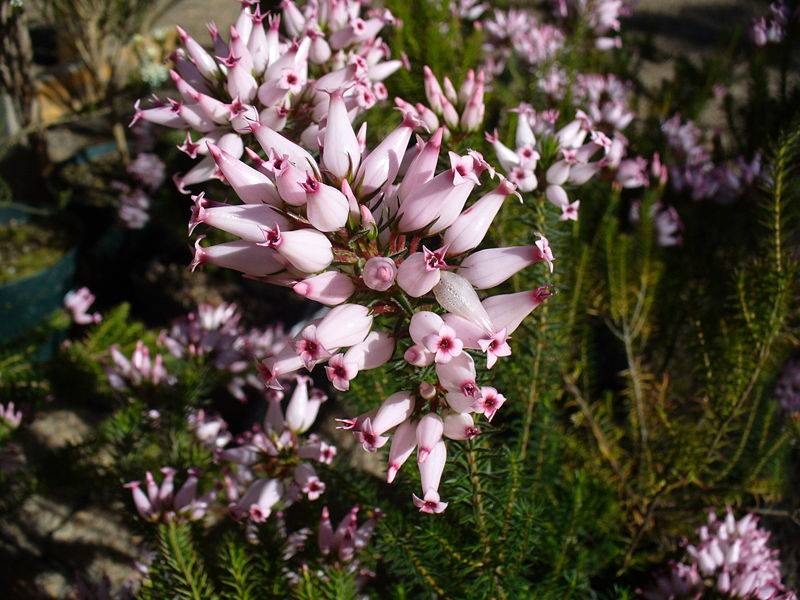

Erica ventricosa
Flower varieties
Eric's plant has in the description a wide variety of species
... However, the most interesting for florists are:
- Erica herbaceous - one of the very first to bloom. Sometimes it is also called blush. Around April, everything is already covered with small bells of reddish or pink shades. In height, the bushes can reach up to thirty centimeters, and some specimens even up to fifty. From this group, varieties can be distinguished: Erica herbal miretown ruby, Natalie, Ice Princess, Isabel, etc.
- Erica graceful (gracilis) - most often this crop is used as a pot plant. Flowers begin to bloom around November and bloom for several months. There are several varieties of this variety, and their main difference is in the color palette: their flowers can have a white, pink or reddish tint.
- Erica Darlenskaya is a hybrid species that was bred by a breeder from England Darley Dale in the early twentieth century. At the moment, it has become widespread throughout Russia. It is characterized by winter hardiness, which is very important for the cool Russian climate, and a long flowering period. About twenty varieties belong to this group of shrubs. The tallest can reach half a meter in height.
- Erica pink is the shortest of all species. In rare cases, the plant grows up to twenty centimeters. It is usually much lower. It blooms around April and has bright, dark red flowers.
- Erica tree is an unpretentious shrub that can grow on any type of soil. It has a curved trunk and pretty white bell flowers with bright red anthers. This plant species has a very fragrant aroma, and the height of some specimens can reach seven meters.
Erica's landing
When landing, very it is important to choose the right soil
... Heather shrubs prefer soil with high acidity, which can even be very acidic. The soil itself can be swampy or dry sandy. Regardless of where the plant is planted - in a pot or in a hole in the open ground - a drainage layer must be present at the bottom, because stagnant water is harmful to the flower.
When planting in open ground, the distance between the bushes should be observed. It should be equal to about 40 or 50 centimeters. Bushes are planted to a depth of 20-25 centimeters. In this case, the root collar should not be deepened.
It is better to leave Erica in one place for two or three years, after which you should find a new place for her. It is better to plant it before it starts to bloom or after flowering.
The soil must be breathable and moisture permeable. As a substrate a mixture of:
- peat, coarse sand and turf in proportions of 3: 1: 1, when choosing a neutral soil, the peat part can be reduced;
- sandy forest soil; rotted needles; peat and river sand (proportion 3: 1; 1; 2)
Required care
It is not difficult to care for a heather shrub, which is why it is so often chosen for planting and decorating the garden. Required follow some simple rules:
- Lighting and site selection. The shrub prefers to grow in a bright place, but the light should be diffused. When it grows in a shady area or where partial shade is present, the color of its flowers may become paler. Their number can also change downward. In addition, it is desirable that there are no drafts at the landing site. It is good if there are hedges nearby that protect the bushes from the wind. At home, pots can be placed on southern, western or eastern windowsills. If a good place is chosen, then Erica will certainly delight the owner with abundant and long flowering.
- Temperature conditions. This point applies more to those flowers that are grown indoors. Erica needs a temperature of about 18 degrees for normal growth. During the flowering period, it should be about half as low - about 7-8 degrees. If it rises, then it is necessary to make the air humidity higher. At temperatures above 21-22 degrees, it is recommended to put humidifiers or put the pot in a container that will contain wet ceramite. You can also spray the deciduous part of the crown.
- Watering mode. It is necessary to water the shrub with a soft type of water, without the presence of impurities. Hard water can kill a flower. More frequent watering is required in summer. However, the soil should not be waterlogged. If the soil in the pot is too dry, then it is better to put it in a container with water and keep it there for forty minutes.
- Shrub pruning. During the first two years after planting, the bush does not need to be pruned. Then, in most cases, formative pruning is required. It is necessary to carefully remove excess shoots, forming a crown. This is best done after the flowers have faded or before active growth begins after a dormant period. When pruning, it is important not to remove old wood.
- Top dressing. From time to time, the plant needs feeding. However, organic fertilizers in the form of fresh manure are not recommended. For these purposes, mineral complex fertilizers are used. Special additives for azaleas or rhododendrons are also suitable. They can be found in flower shops. In this case, the dosage is slightly reduced. When fertilizing, fertilizers are applied to the soil, while it is necessary to ensure that the solution does not get on the foliage, otherwise it can cause a burn. Often it is not necessary to fertilize the flower; it is enough to do it once a year in the spring, adding the mineral composition to the water.
Plant propagation
Erica is propagated in several ways. These include:
- cuttings;
- reproduction using layering;
- seeds.
When grafting, cuttings should be cut into a length of 2-3 centimeters. Then they are planted in a soil mixture (2 parts of peat soil and 1 part of sand) and deepened by 1/3 into the ground. Sprinkle the resulting seedlings on top with a layer of sand about a centimeter thick.
After the procedure, containers with planted cuttings should be covered with foil or glass and placed in a place where the air temperature will be approximately 18-20 degrees. They should be shaded from the sun. After about a month, the seedlings should take root. All this time they need to be fed with micronutrient fertilizers
or use a weak urea solution.
Reproduction by layering begins in the spring.At this time, stronger shoots are chosen on the bush and tilted to the ground. Then they must be fixed in this position. Wire is suitable for this. Sprinkle them on top with soil and moisten them. After a while, they take root and can be planted separately.
The seed method of reproduction is the longest and most laborious. To sow them, you need to prepare a special soil, which should consist of heather soil, coniferous and sand (2: 1: 1). The seeds are very small, so they are not planted in the soil, but poured directly over the surface, slightly pressing them to the ground. After that, you need to moisten them with a spray and maintain high humidity. It is also necessary to cover them with glass or film and maintain a temperature of 18-20 degrees. A month later, the first shoots should begin to appear.
If the bush is already old, then it can be propagated by dividing the bush. To do this, it should be dug up and simply divided into several parts, and then these parts should be planted again.
Indoor "heathers" and their catchy beauty
Representatives of the genus Erika (Erica), who in nature are considered a permanent adornment of the Scandinavian and British landscapes and are known mainly for the beauty of the moorlands, are able to surprise with their diversity. In the genus Eric, which is part of the family of the same name, there are more than 5 hundred species of plants. And although most of them remain wild plants that have not been introduced into horticultural culture, and the most famous erikas are garden plants, there are still among the five hundred varieties and those species that will not refuse to grow as a solo indoor plant. Genuine heathers (Calluna) are also grown in indoor culture, but their maintenance requires a slightly specific approach and heather must be outdoors for most of the year.
As a houseplant, only two are grown, but incomparable types of Erica - Erica grassy (Erica herbacea), which has many great varieties with different colors of inflorescences and is less capricious, but also less effective erika graceful (Erica gracilis). Both plants have a lot of similarities in the type of flowering, and in size, and in the structure of the bushes. Moreover, almost all specimens on the modern market are hybrid varieties and their specific origin is sometimes not entirely easy to find out. And species of plants are often confused with each other and sold under each other's names. But you can still distinguish the herbal Erica from the graceful one: in the first, the flowers are painted only in pink or red, in the second - in pink-lilac-purple tones. Everything else in plants is very similar. They are actively experimenting with other types of eric today in the West, trying to increase the range of these plants in indoor representation, but there is no talk of any noticeable "breakthrough" of other types of speech. On sale today are sometimes found Eric Wilmore (Erica x willmorei) with long, up to 2 cm bells of flowers and growing in the form of a spherical bush Erica bloated (Erica ventricosa), but they are rare.
On a note. If you have copies of other eric species or heathers in your garden, you can try growing them as a houseplant using the cuttings method and not transferring the plants after rooting to open soil, but replanting them into a pot and adapting them to indoor conditions from an early age. These are great plants to experiment with.
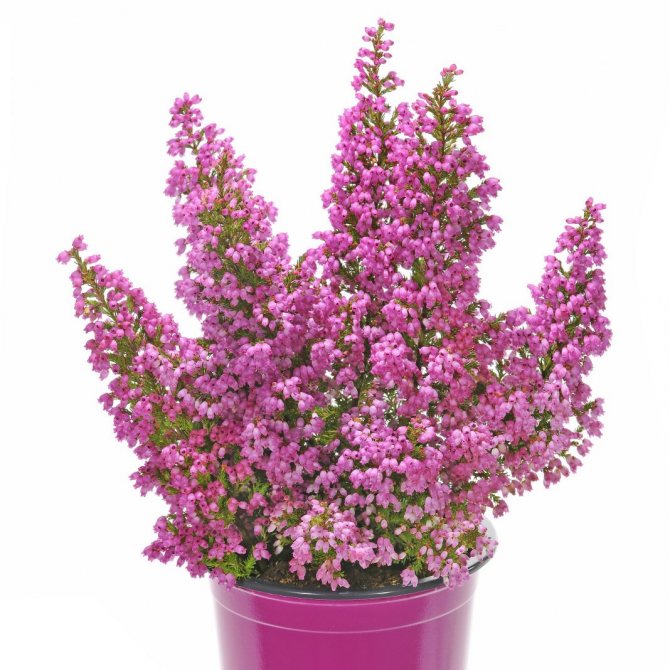

Erica Gracilis
Indoor eriks are undersized, very dense evergreen shrubs, the maximum height of which does not exceed half a meter, and often is completely limited to 40 cm.The diameter of the bushes always exceeds their height, in healthy and strong specimens it can reach 60 cm or more. These shrubs are constantly growing and, if grown as perennials, require larger containers or timely separation. Erik's shoots are erect, densely branching, forming a dense crown.The leaves are typical of all heathers, strikingly small, rich medium to light to dark green color, needle-like, densely arranged, which creates a unique crown texture.
But despite all the beauty of the greenery, flowering remains the most noticeable feature of indoor eriks, like their garden counterparts. The apical racemose or spike-shaped, elongated inflorescences, consisting of bell-shaped, often almost spherical, miniature, brightly colored flowers, conquer both with an amazing palette of colors and the ability to produce inflorescences in unimaginably large quantities. Small flowers in dense inflorescences are in harmony with small leaves. During flowering, the bushes are so abundantly strewn with inflorescences that they turn into a single color (and textural) spot.
Indoor eriks traditionally bloom on the eve of winter or at the very beginning and flaunt with flowers until spring. At this time, the rich shades of the red spectrum - pink, lilac, purple flowers - are unusual and unique, not found in any other plants, except for heathers, or white-flowering elegant varieties of Erica seem to be an outlandish vision and real strangers in interiors.
To succeed in growing indoor Erica as perennials, it is enough to keep them cool. This is the main and basic requirement of these plants, but far from the only one. Eric can hardly be called an easy-to-grow culture, this plant is suitable only for experienced growers who are ready for difficulties, able to provide this heather beauty with special care and special conditions of detention. This plant is for connoisseurs looking for original accents and non-standard solutions. All the difficulties in growing Erica are more than compensated for by her beauty. Today, it is considered one of the most promising and fashionable among winter seasonal plants. But we are just beginning to look closely at it, and on sale flowering bushes just for indoor maintenance can not be found so often.
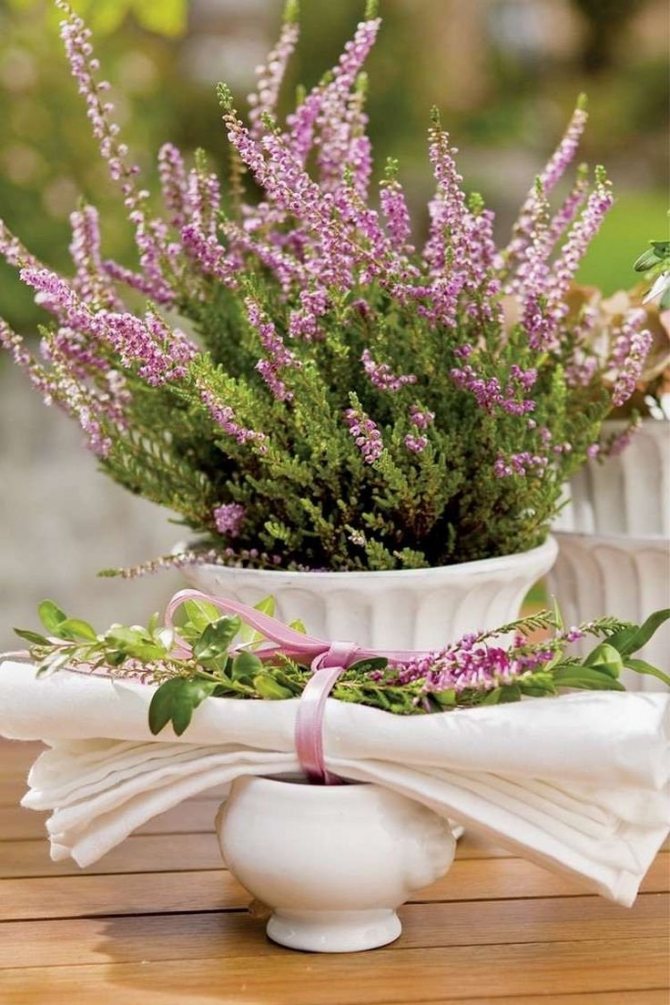

Composition from Erica
Room keeping principles
We used to think of Eric as a British landscape delight. Hearing this melodious name, we recall the Scottish moorlands, the famous ballad by Robert Stevenson "Heather Honey". Today it is an affordable ornamental plant that can be grown in a pot on a windowsill.
In indoor conditions, as a rule, two varieties are grown - E. herbaceous and E. Graceful. Their life expectancy is very short. In fact, this is a living bouquet that does not fade for six months, and then dries up, no matter how much we want it.
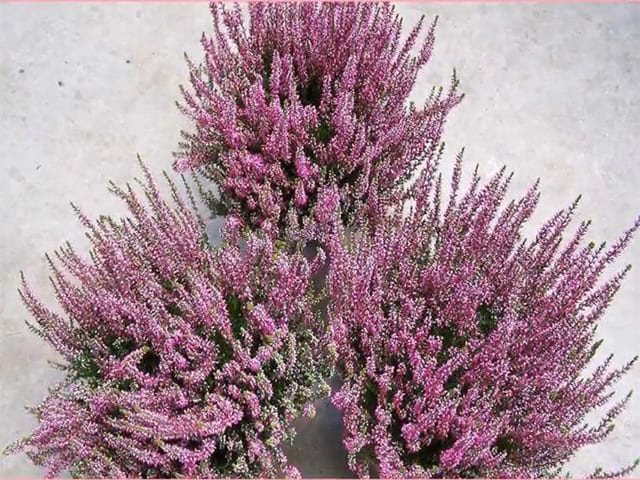

There are some features of caring for him: the composition of the soil, moderate sun, but all this is beyond the concern of a caring owner. To enjoy the view of this beauty, you need to spend a little of your time studying the peculiarities of the climate and soils of the regions where her ancestors grew. You can just read the recommendations in this article.
Lighting
Erica is light-requiring. Place it in the sunniest room, but so that the sultry summer rays do not burn or dry out the shoots. If you take it outside in the summer, it is better to put it in partial shade. The summer sun instantly dries up the soil, and this is destructive.
You don't need to place it in full shadow either. Otherwise, the shoots will stretch in length, the flowers will become sparse, small and dull.
Comfortable temperature
Erica is fickle, like an eccentric beauty. Its temperature regime must be constantly changed depending on the season, air humidity and other factors.
The most successful temperature for such a plant is up to 15 degrees. In the summer, during the rest period, Erica is more unpretentious. If you periodically ventilate the room, no further manipulations are required. Loves fresh air. In an unventilated room, it is necessary to observe a temperature regime of no higher than 15 degrees. Otherwise, the beauty will begin to fade, it will be more susceptible to diseases and pests.
At the end of autumn, it is better to place it in a cool place: on a loggia or terrace, where the temperature does not rise above 6-8 degrees. Then the bush will delight you with rapid flowering in winter and spring.
Watering and air humidity
Erica is hygrophilous and needs watering. If the air temperature is high, the soil dries out quickly, you need to water it often. However, do not allow stagnant water to appear in the sump. The soil should be moist - no more.
Lower temperatures require less moisture, so water gently. The water should be soft, at room temperature.
Air humidity must be at least 60%. It is best to locate a humidifier nearby. Some growers do it differently: they place a flower pot in a container with damp decorative soil, peat, sand, moss.
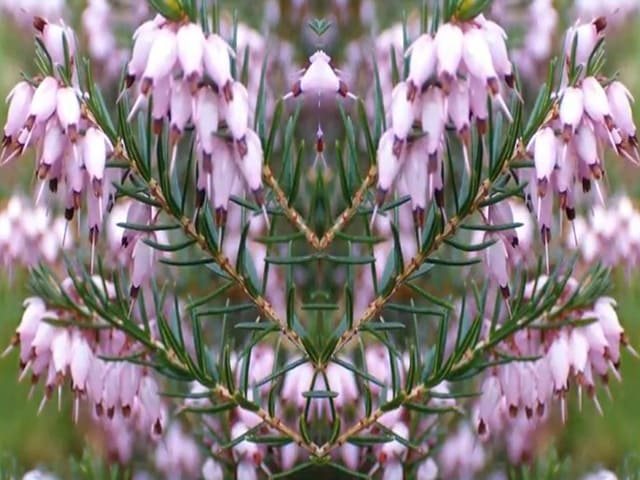

Top dressing and fertilizers
Does not tolerate mullein in the soil. Therefore, refrain from these fertilizers, which are suitable for many other indoor plants. Purchase a special water solution for azaleas and rhododendrons. They also prefer an acidic substrate. Proceed according to the instructions, for heathers it can be diluted in a lower dosage.
When fertilizing the soil, try not to get on the leaves and shoots. The solution can leave burns, damaging the flower and spoiling its decorative effect.
Pruning
There is no need to shape the shrub by pruning. By its nature, it is thick, dense and fairly regular in shape. To remove dried inflorescences, just shake it a little. Remove fallen flowers.
Transplant and substrate
If, after flowering, you decide not to get rid of it, but to preserve it, you can transplant it into another pot or garden. The transplanting method is simple - "rearrange" from one soil substrate to another - fresh.
Do not root out the soil. Immerse the plant in the new potting mix with the soil clod adhered to the roots. So it will take root faster.
It doesn't matter when to transplant room Erica. The main thing, of course, is not in winter.
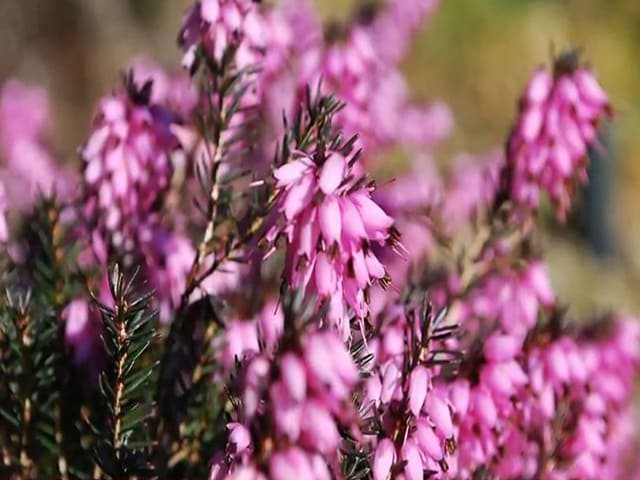

The soil substrate should consist mainly of peat, since Erica naturally grows more often in swampy areas. Sand, coniferous humus can be added to the acidic substrate. Suitable substrates for rhododendrons.
Diseases and pests
An indoor flower, it would seem, should be less susceptible to attack by insect pests than a garden flower. However, it is not. The garden flower is stronger and stronger. It is in the air, which is important for such a plant. Indoor specimens are susceptible to many diseases that provoke the following factors:
- Low room humidity;
- Overdried substrate;
- Improper watering;
- Attack of scale insects and spider mites;
- Lack of minerals in the soil;
- Violation of oxygen supply to the root system (the top layer of soil in the pot must be periodically loosened).
As a result, the following diseases are possible:
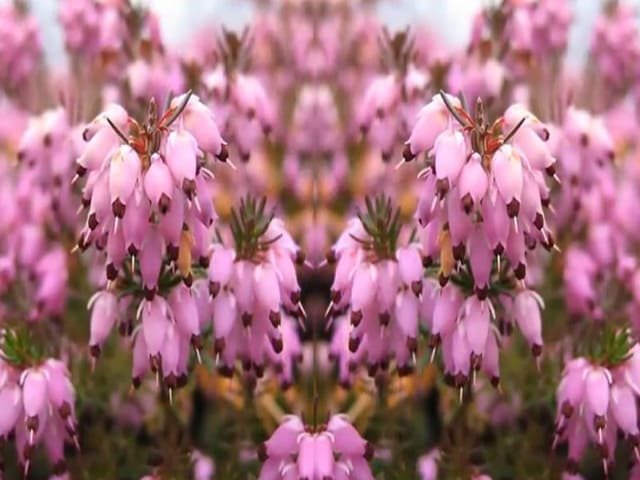

- Gray rot;
- Fungi;
- phytopathogenic viruses and bacteria;
- Mixed chlorosis;
- Leaf blade necrosis.
The leaves begin to turn yellow, the plant dries up, and the flowering stops. Fallen leaves and flowers are immediately destroyed to prevent re-infection.
It is difficult to collect scabbards by hand and wash them with a leaf, therefore, in case of an attack, immediately use insecticides.
Growing conditions for Eric and Heathers
Eriks and heathers love sunny, dry, sheltered places. The ideal soil for them is humus, easily permeable, acidic (pH 4-5.5) soil. Heathers do not grow well in very humid places and do not like excess moisture.
Every type of garden soil can be corrected before planting Eric and Heather seedlings. To do this, mix the garden soil with a suitable organic material (peat,) and use the mixture to plant the plants.
If the acidity of the garden soil is not suitable for growing Eric and heathers, then it is necessary in the place where we want to plant the plants, remove part of the earth with a depth of 10-15 cm.Then pour peat with the required pH value and dig the ground to a depth of 25-30 cm, mixing the garden soil with peat.
Eric and heather bloom
Depending on the climatic zone of cultivation and on the varieties of Eric, they begin to bloom at different times.
For example, the spring months - March, April and May - are the time of flowering for most varieties. Erica Blush
, or
Erica herbal
(Erica carnea = Erica herbacea).
In the second half of June bloom: - Erica Bolotnaya
(Erica tetralix); -
Eric Watson
(Erica watsonii); -
Erica Ash
(Erica cinerea). Blooms a little later
Erica lying
(Erica vagans).
Heathers begin to bloom in the summer. The earliest varieties of heathers bloom at the end of July. Heathers bloom until November.
Basic rules for caring for eriks and heathers
Fertilizer.
Heathers and ericas are not very demanding on soil fertility. Fertilizer for feeding these plants is enough to apply once a year, in early spring. It is recommended to use multi-component fertilizers. For example, we have: AZOFOSKA, HYDROKOMPLEX (Polish production). Slow-acting fertilizers are used (eg OSMOCOTE or other acidic soil fertilizer).
Preparing for winter
... Most varieties of eric and heathers require. Coniferous branches are a good cover for these plants. You can also use jute mesh or a shading fabric made of synthetic material (it will last for several seasons). Covering heather plants with leaves, straw or foil is not recommended.
Pruning.
A prerequisite for the proper development of eric and heathers is pruning, which promotes rich flowering and good plant growth. It is recommended to trim smaller specimens with pruning shears. And large bushes growing in the massifs are more convenient to cut with special scissors. These plants should be cut below the flowers that are already fading. Heathers and several types of erica (eg Erica tetralix, Erica vagans, Erica watsonii are best pruned in early spring, while erica species Erica carnea and Erica darleyensis are pruned in May or early June, immediately after flowering.
Disease and pest control
... If heathers and ericas grow in a suitable place and are well cared for, they are immune to pests and diseases. But sometimes these plants can be affected by fungi such as Botrytis (gray mold), Rhizoctonia, Phytium, Glomorella. In our climatic conditions, most of the diseases in Eric and heather usually appear in July, which is facilitated by high humidity and air temperature. When the first signs of disease appear, prophylactic spraying of plants with suitable fungicides is recommended (for example, we have: Srbravit, Rovral, Euparen).
Magdalena and Marek Majewski (Heather Plant Nursery, Poland) https: //.
On the site on the site on the site on the site on the site on the site
Weekly Free Site Digest Site
Every week, for 10 years, for our 100,000 subscribers, an excellent selection of relevant materials about flowers and garden, as well as other useful information.
Subscribe and receive!
Erica is a small but very attractive shrub with unusual leaves and bright flowers. It is quite often used to decorate personal plots, squares, parks and gardens. Due to its beautiful appearance, as well as unpretentious care, the plant has earned the recognition of many flower growers.
Where is the best place to put Erica
When choosing a place for Erica, it is necessary to take into account the fact that under natural conditions the shrub grows on well-drained and breathable soil, which means that similar conditions must be provided in home cultivation, because stagnant water in the root system can lead to flower diseases.
As for the place, the plant does not tolerate direct sunlight, therefore, it is better to choose a well-lit, but cool area.
Based on this, Erica will feel great on the east, or east-west window.
The soil should be acidic, with a pH of 3-4. Soil is best for Erica, consisting of turf, peat and sand.
Heather and Erica differences.These unusual shrubs
With the arrival of planting material from Polish and Dutch nurseries to our market, Russian gardeners faced the problem of choice. Many exotic plants have appeared, previously unknown to a wide range. Such plants include heathers and erika - extremely attractive small plants that are sold in bloom in spring and autumn. They look like small Christmas trees covered with small pink, purple or white flowers. Naturally, these plants immediately attracted the attention of gardeners, but, unfortunately, due to ignorance of the agricultural technology of growing heather and erica, they do not always take root and grow well in our gardens. In fact, these are extraordinarily attractive evergreens, reaching a height of 20-30 cm, and also having a long flowering period. As a rule, ericas bloom from early spring to early summer, and heathers bloom in late summer and leave before winter with flowers. In addition, there are many varieties of heathers, not only with different shapes and colors of flowers, but also with different colors of leaves - green, blue, yellow. In Western Europe, heather gardens have long been created, the advantages of which are obvious: they take up little space, consist mainly of evergreens, perfectly combine with stones, with other heather plants, such as rhododendrons, as well as dwarf conifers. Heather gardens retain their decorative effect throughout the season, are relatively unpretentious and easy to care for, are not afraid of spring and autumn frosts. Their disadvantages include the costs and laboriousness of laying a garden and the need to shelter it for the winter. These dwarf plants can perfectly complement the rock garden, they are good for decorating the shores of reservoirs, especially in combination with low coniferous shrubs and small bulbous ones. In Europe, heathers and erica are widely used to create autumn and winter container compositions that decorate the entrances to buildings and public places. They are especially often used for decoration for Christmas and New Years.
Erica - home care
If you grow Erica indoors, it is advisable to take her out to the balcony or loggia more often. The plant is very fond of good light, and also needs fresh air. Pruning is an important prerequisite for caring for Erica. Shoots are pinched or pruned, not only to stimulate the growth and bushiness of Erica, but also to give the bush a decorative, neat shape. From time to time, faded "bells" are removed from the plant by shaking off.
Video - Erica pink, evergreen low shrub.
Watering Erica is rarely watered in winter. In the summer months, when the plant blooms profusely, and its shoots lengthen very quickly, good regular watering should be ensured. But it is impossible to allow stagnation of moisture in the soil.
Temperature Sudden jumps in temperature are detrimental to Erica. The plant is very thermophilic and does not tolerate drafts, cold winds. In winter, it is best to place it on the windowsills above the heating radiators, while ensuring sufficient humidity.
Top dressing Fertilize the plant very carefully. Organic matter for feeding is not suitable - it can "burn" the shoots and stems. It is best to use store-bought mineral formulations that are diluted less than recommended on the packaging. Fertilize the soil just before flowering.
Transfer Erika needs to be repotted at the end of each winter. At the same time, after removing the plant from the pot, it is placed in a jar or other vessel with water for 1-2 hours, after which it is planted in fresh peaty soil.
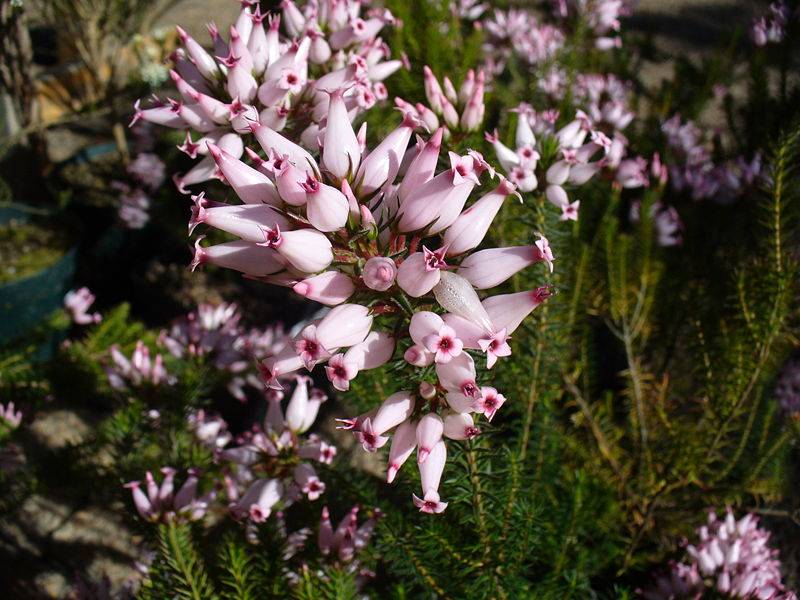

Erica ventricosa
Site selection and soil preparation
Erica is a light-loving shrub that does not tolerate direct sunlight. When grown at home, it is placed on the eastern window sills. In the garden, slopes facing east or west are suitable. You can plant shrubs under trees so that their crown shades planting at noon.
Erica's branches are fragile, so the plant is planted in places protected from the wind.
The shrub grows in well-drained, nutrient-rich soil. The stagnation of moisture at the roots is destructive. A good substrate composition should include turf, humus, sand and peat. The acidity of the soil is different for different species. For example, Erica Darlinska grows only in acidic soil, and ruddy soil needs neutral.
In the garden, the shrub is planted only in spring, when the soil warmed up to at least +10 degrees. In the middle lane and the Moscow region, the plant is planted in May. Autumn planting is possible only in southern regions with warm winters, and even then there is a risk that the plant will not have time to take root.
Erika grassy "Kramers Rote" (Kramer`s Rote) P11 1 seedling per pack
×
Transplant and substrate
Despite the fact that Erica is most often thrown away after flowering, it is quite possible to keep it as a perennial plant, in which case she will need a transplant. After flowering, it can either be transplanted into the garden in open soil, or transferred to a new pot. The timing of the transplant is not critical for Erica: it can be carried out immediately after pruning, or it can be done only at the beginning of spring, when the weather is stable and warm and daylight hours begin to increase.
It is very easy to choose a substrate for Eric. It must necessarily be acidic, consist mainly of peat or be pure peat, be coarse, sufficiently dense. Erica responds well to substrates for rhododendrons, a mixture of equal parts of coniferous, peat soil, humus and sand.
The transplant procedure for this plant is not quite typical. It is advisable to load Eric, keeping an earthen lump around the roots. A middle drainage layer is laid on the bottom of the tank. But during transplantation, the soil is not left loose, but very well tamped over the roots, creating a dense layer of soil that perfectly holds the shrub.
Popular in the Moscow region species and varieties
Erica herbal (ruddy). A dwarf evergreen shrub that forms a lush cushion of delicate greenery. Reaches 20 - 40 cm in height, up to half a meter in width. The shoots are tough, the needles are small, and when the weather gets cold they acquire a bronze color. Abundant flowering occurs in April - May. The flowers are small, arranged in a one-sided raceme, pink, red or white. Blooming Erica exudes a pleasant honey scent. It grows very slowly. Winter hardy. Varieties:
- Aurea is a variety with yellow-colored foliage and pale pink flowers;
- Challenger - with bright crimson flowers;
- Gold star - the foliage has a golden hue, the flowers are white;
- Isabel - snow-white bloom;
- Rosalie - pink flowers;
- Rubra - pink inflorescences with lilac tint;
- The Snow Queen is a variety with white flowers;
- Winter beauty - flowers of a rich pink hue;
- Winter ruby - the flowers are bright red.
Erica is graceful. A bush, half a meter high, pyramidal in shape. Leaves are linear, up to 4 mm, light green. The flowers are bright red, appear on the plant in October and bloom all winter. This variety is grown as a houseplant.
Erica cruciferous (four-dimensional). Lush shrub with a height of 40 - 50 cm. Needle foliage, gray-green color. Blooms in mid - late summer with red or pink flowers. Varieties:
- Ardi - flowers are dark pink with a lilac tint;
- Pink shine - pink-purple flowers;
- Silver bell - white flowers with a silvery sheen;
- Pink star - pink bloom.
Erica darlenskaya. Evergreen, spreading shrub up to 50 cm high. It grows quickly and is distinguished by abundant flowering of pink or purple flowers. Varieties:
- Flattened silver - a variety with dark green foliage and white flowers;
- Darley Dale - profuse lilac-pink bloom;
- The setting is purple flowers with a pink tint.
Erica is pink. Winter-hardy species, reaching a height of 50 cm. Grows quickly, blooms pink.
Erica seeds. Erika
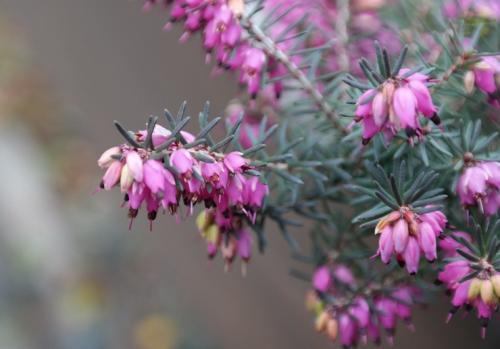

Erica (Erica) - evergreen shrubs from the Heather family, numbering in its genus more than 500 different species. In their natural environment, plants can be found in the Mediterranean and South Africa.
The high decorative qualities of erica allow it to enjoy well-deserved respect among landscape designers. Erica flowers are often used for landscaping household plots and decorating areas near buildings. It can be planted as a ground cover plant. Among the many species and varieties, there are bushes with different shades of leaves and flowers, with a varied shape and duration of flowering. The blooming culture is perfectly combined with other natural specimens and can feel harmoniously in various compositional solutions. Excellent companion plants for evergreen shrubs are rhododendrons, thuja, junipers and other conifers. One of the features of Erica is a wide palette of her colors and shades - from delicate pastels to bright and rich pinks, purples, oranges and yellows.
Planting and caring for Erica outdoors
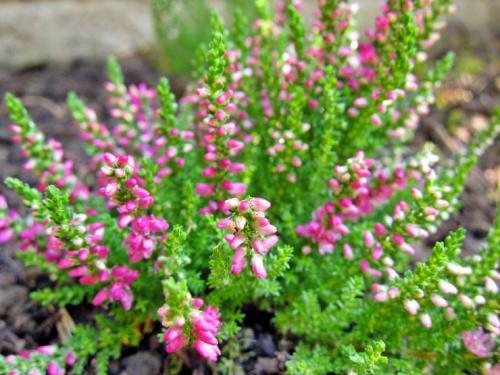

Location
It is recommended to choose an area for planting Erica that is sunny and illuminated for a long time during the day, protected from cold drafts and strong gusts of wind. The splendor and duration of flowering depends on the amount of sunlight. Conifers or deciduous hedges can be used as wind protection. Small buildings can also serve as a windbreak. The light-loving and heat-loving Erica needs full-fledged warmth and lighting.
The soil
Most of the varieties and varieties of erica prefer to grow in acidic soils, but some species grow well in neutral and slightly alkaline areas.
Watering
It is necessary to water the moisture-loving plant regularly and generously, especially during hot summer days and during dry periods. Watering should be done every day, especially in the first year after planting.
Mulching
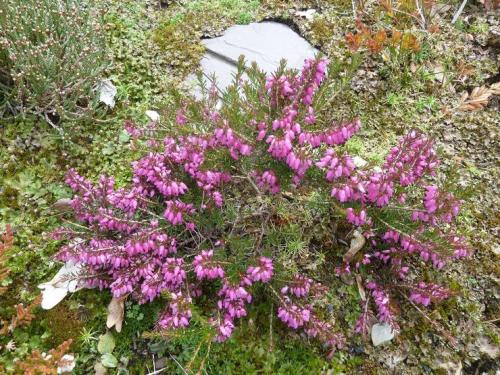

In the evergreen erica shrub, the root part is located close to the surface of the earth, so it needs additional protection in the form of a mulch layer of peat, rotted foliage or pine needles. Mulch will not only protect the roots, but also prevent the appearance of weeds, retain the necessary moisture in the soil and maintain the acidity level of the soil.
Growing Erica in winter
Erica has a low level of winter hardiness and weak resistance to cold, therefore, in regions with snowless and little snowy winters, and even with very strong and prolonged frosts, thermophilic crops must be protected with additional shelter. In the autumn, a thick mulching layer of peat is applied to the trunk circles near each bush, and the bush itself is covered with spruce branches in the form of a small hut in large quantities. It is recommended to remove the cover in early spring to provide crops with free access to sun and air and to ensure full development.
Reproduction of Erica
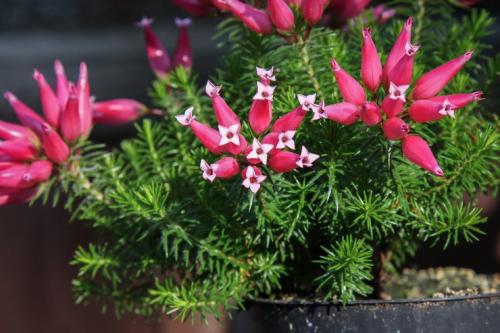

Erica reproduces by seeds, cuttings, bush division and layering.
Seed propagation
The seeds are sown in small planting containers with a moistened acidic soil mixture. It can consist of two parts of peat and one part of coarse sand and coniferous land. Sowing - shallow, without embedding. The box with seeds is covered with glass and kept in a warm, bright room with a temperature of about 20 degrees for about a month. When shoots appear, it is very important to regularly moisten the soil and maintain high humidity. The grown seedlings dive into individual pots. Shortly before transplanting, the plants are hardened and gradually accustomed to open air.
Propagation by cuttings
For grafting, apical cuttings 3-5 cm long are used. They are rooted within a month in a peat-sandy substrate. Care consists in watering and feeding.
Reproduction by dividing the bush and layering
Reproduction by layering and dividing the bush is considered the most convenient and popular way. Young seedlings adapt very quickly to new growing conditions and a new place.
Diseases and pests
Possible diseases are powdery mildew, rust, various fungal and viral infections. Most often, the reason for their appearance lies in the violation of the rules for caring for plants. An excess of moisture in the soil and high humidity can lead to the appearance of gray rot. As a preventive measure, it is recommended to plant crops only in well-lit areas and avoid wet soils and the proximity of groundwater. Another reason for the onset of fungal disease can be a winter shelter with high humidity and little air access. Control measures - fungicide treatment. In case of a viral disease, when deformation of leaves and flowers occurs, it is better to remove the plant. Erica is practically not affected by pests.

